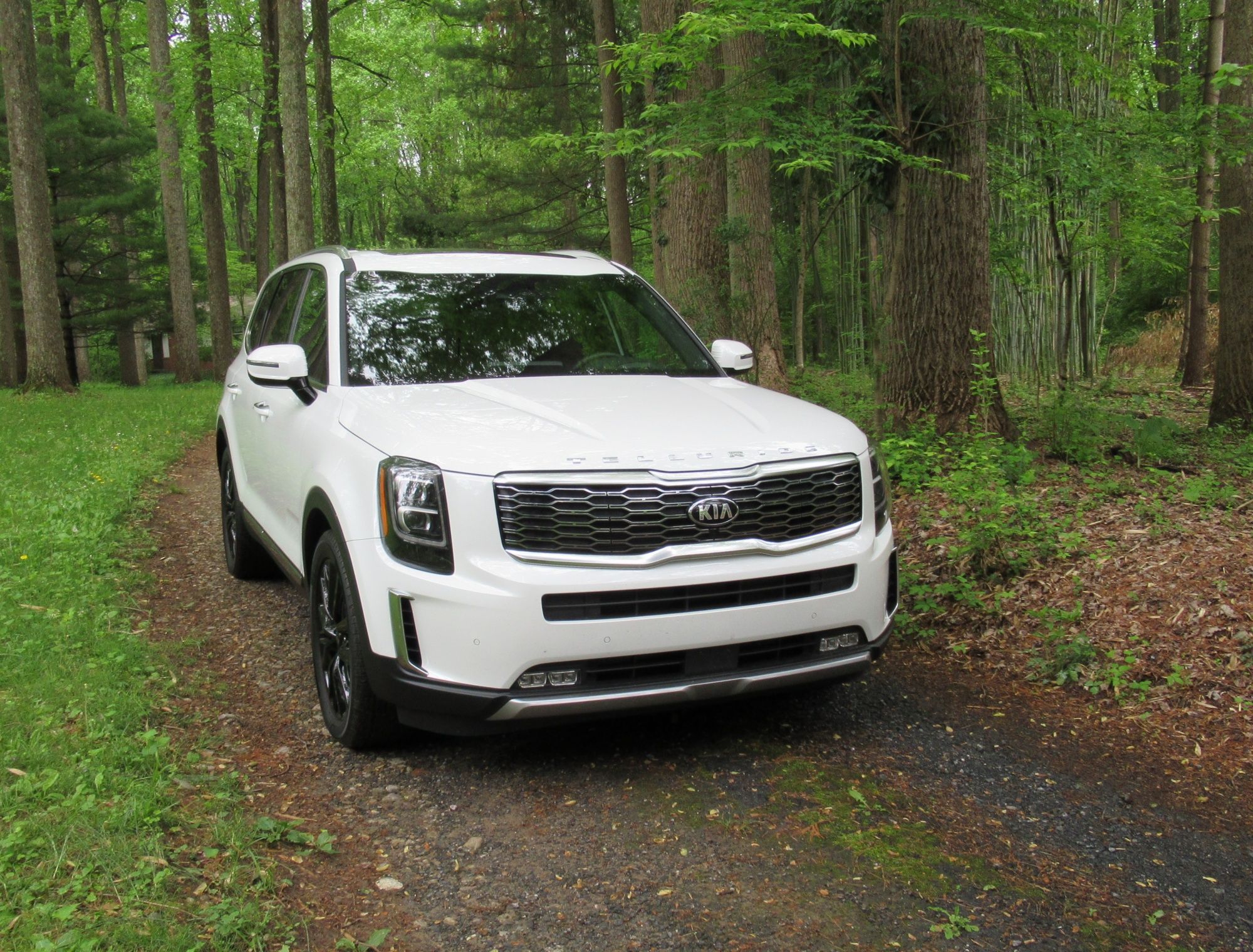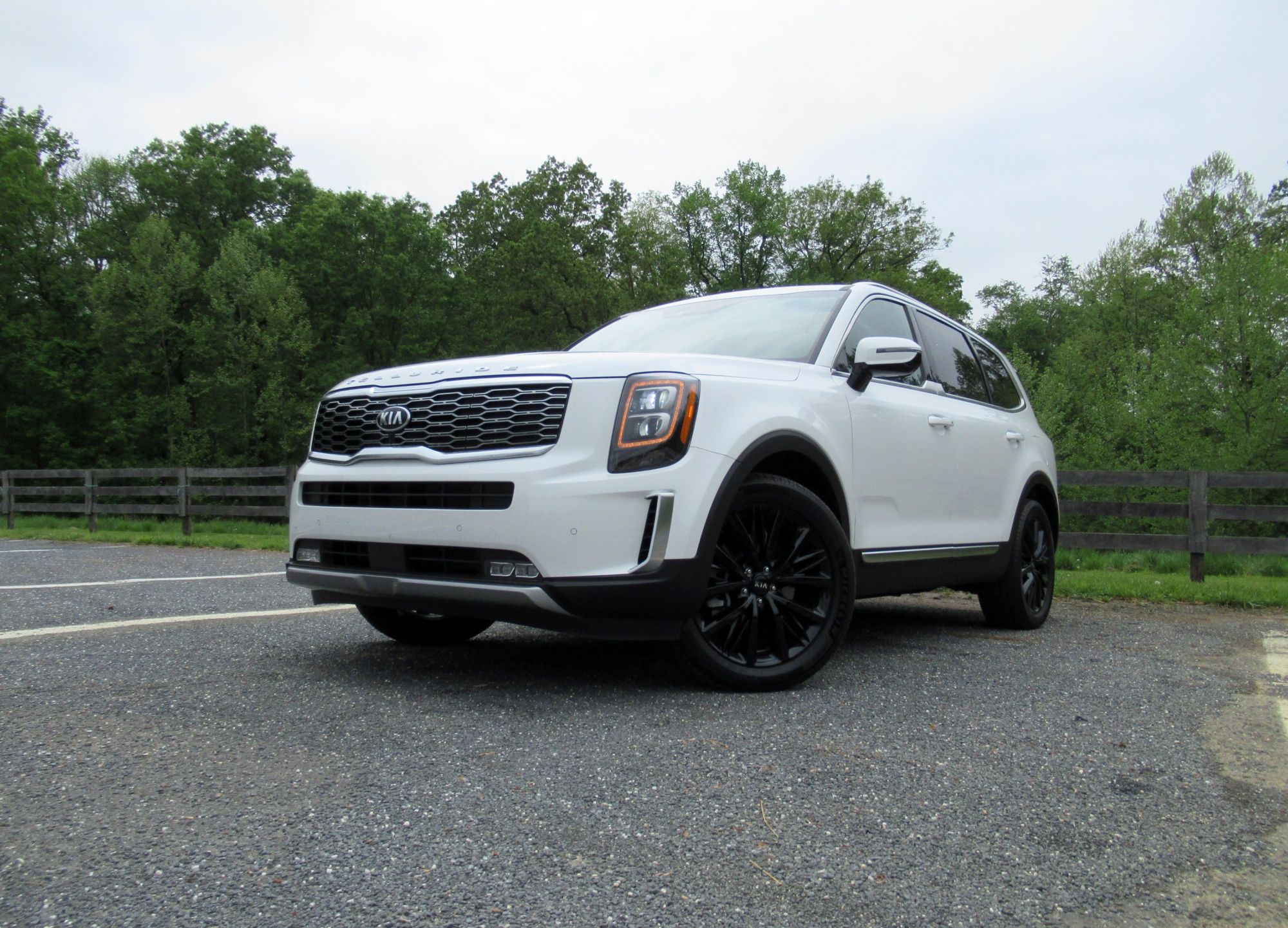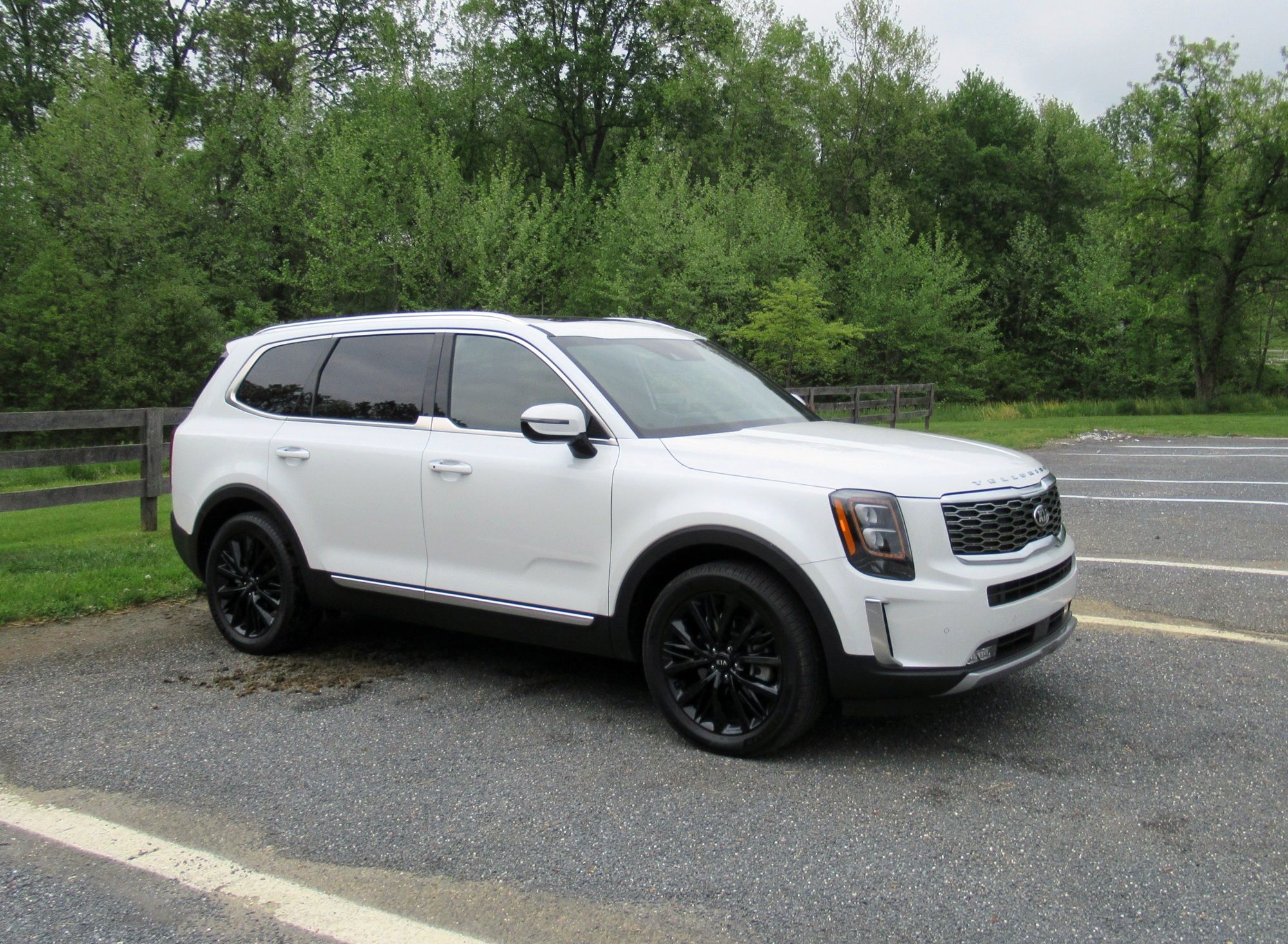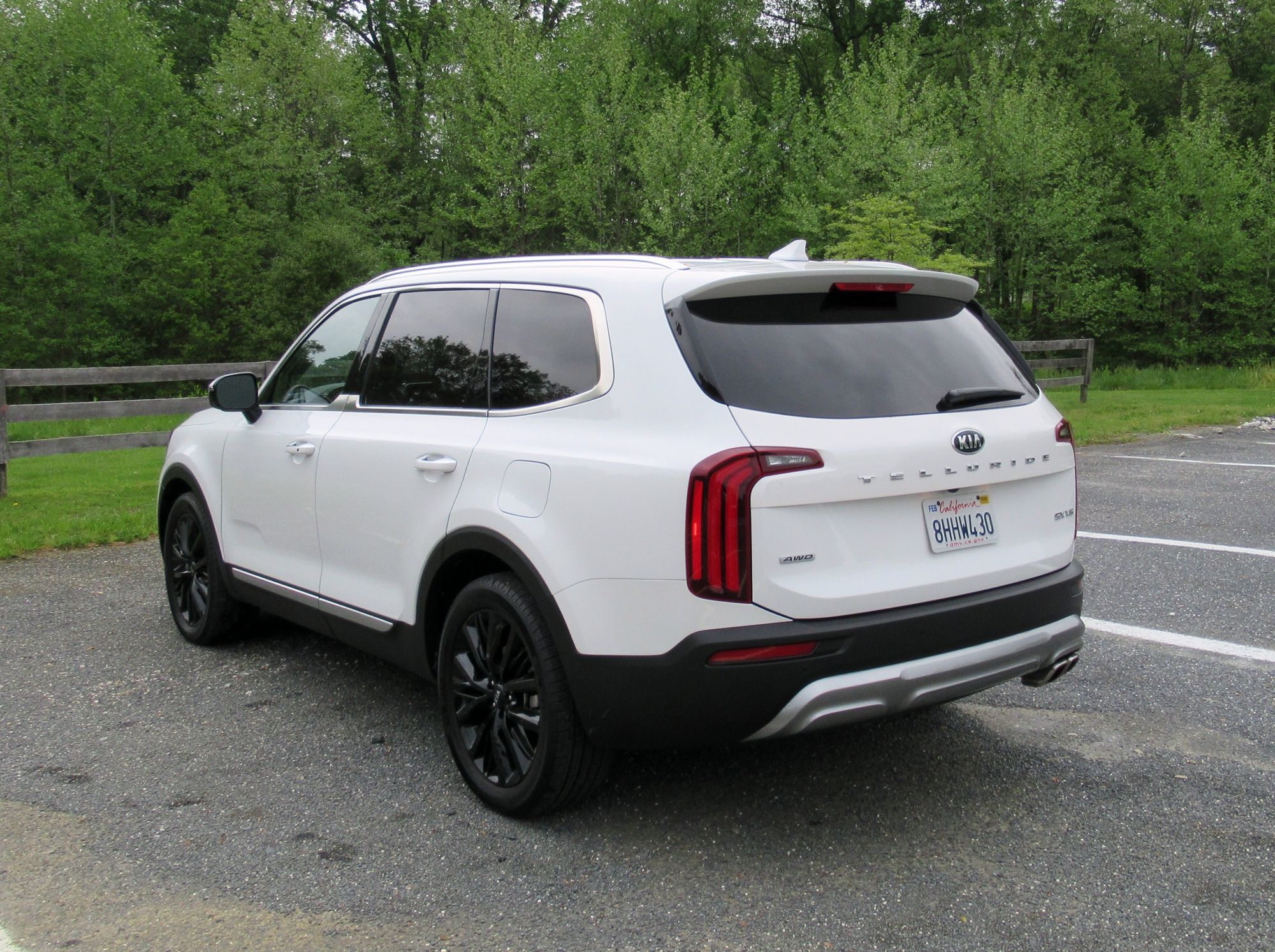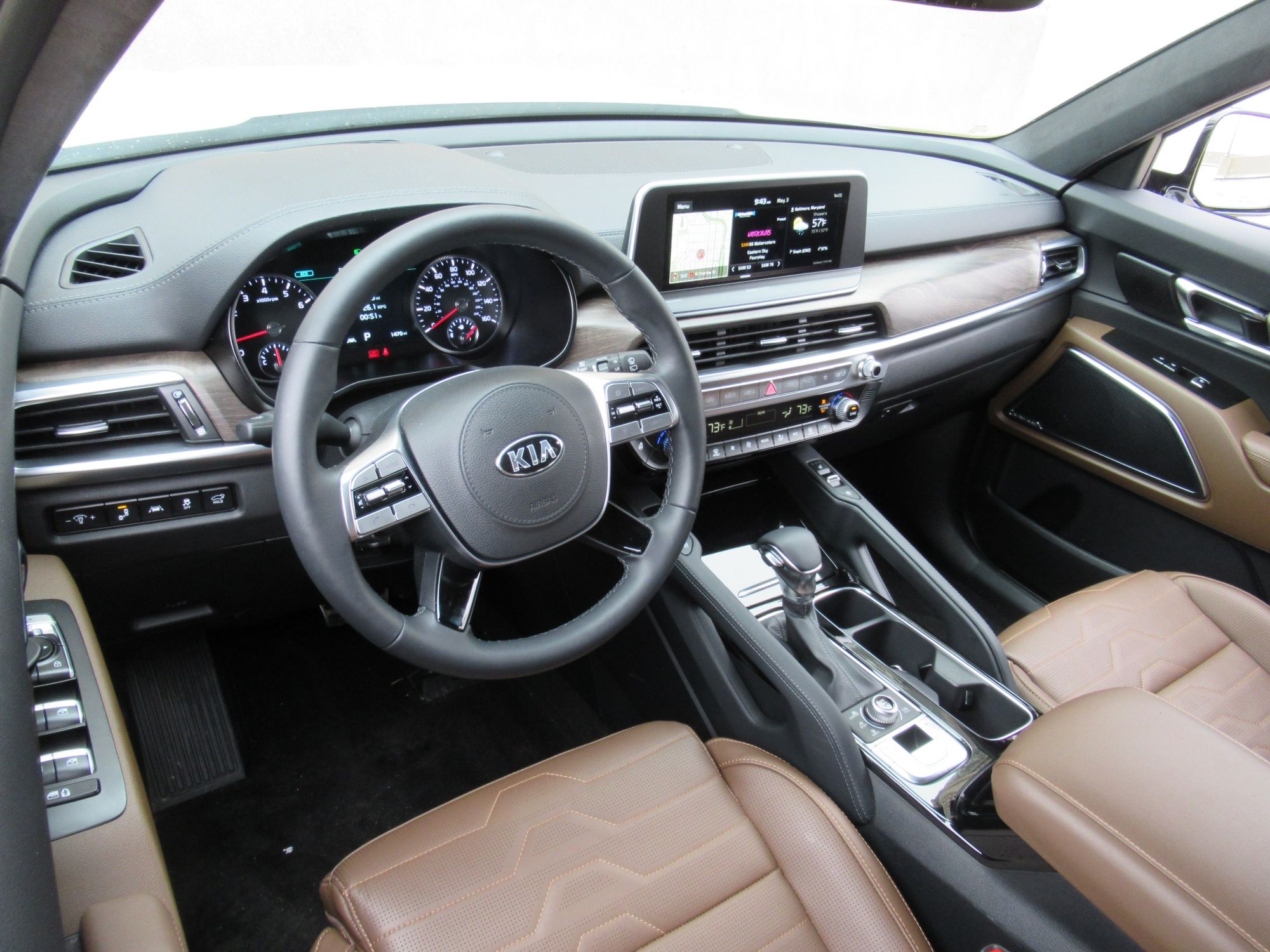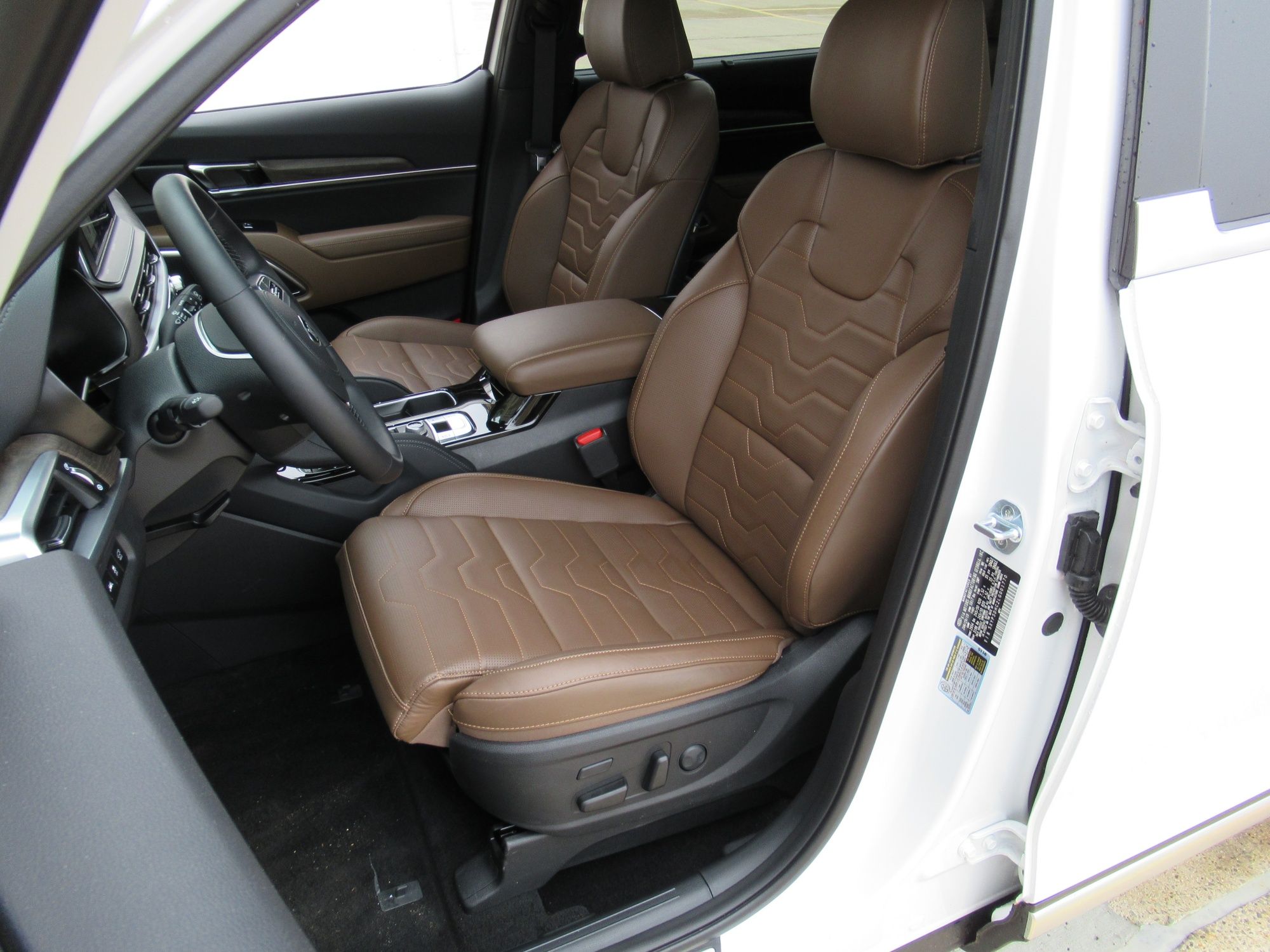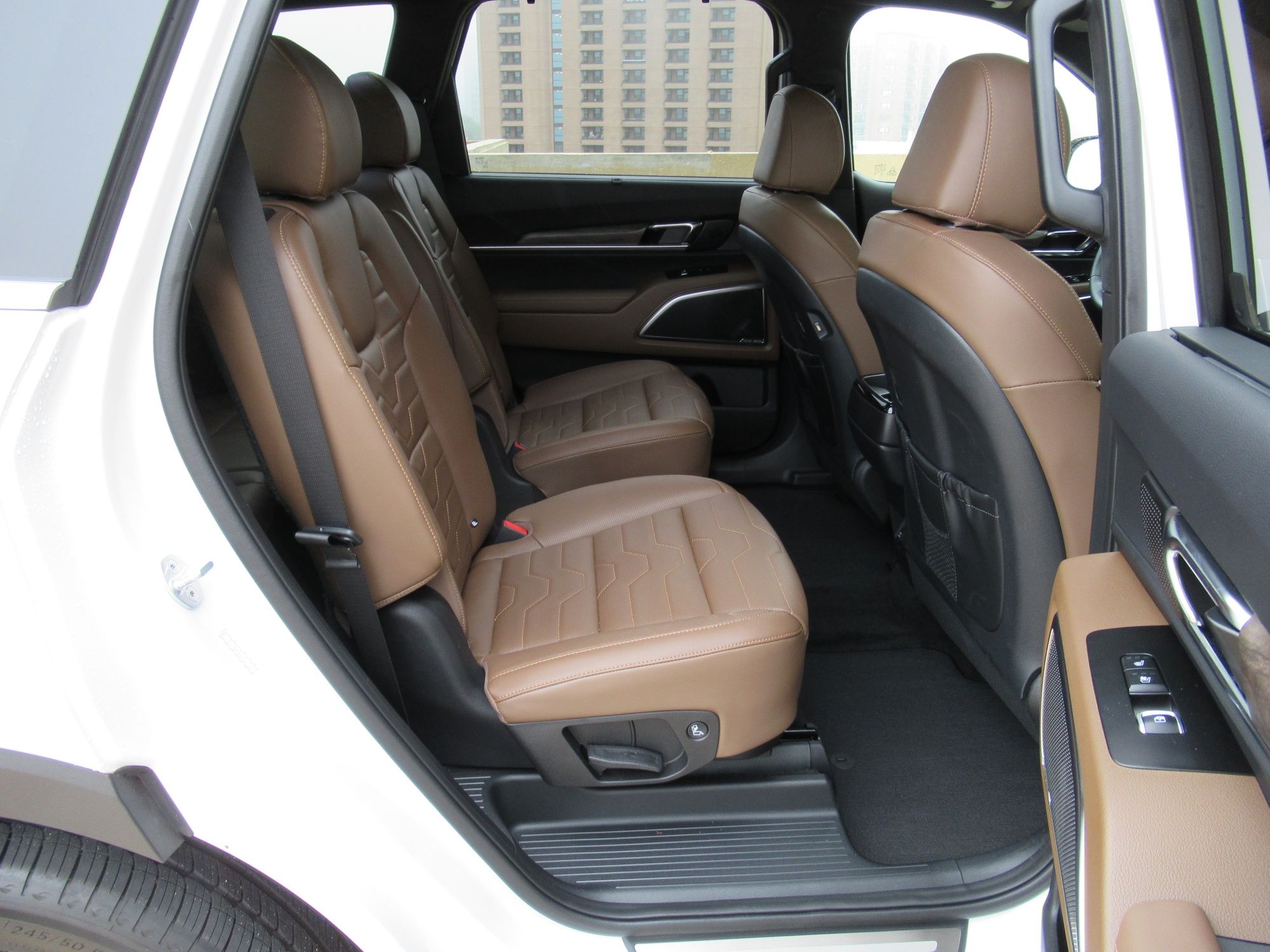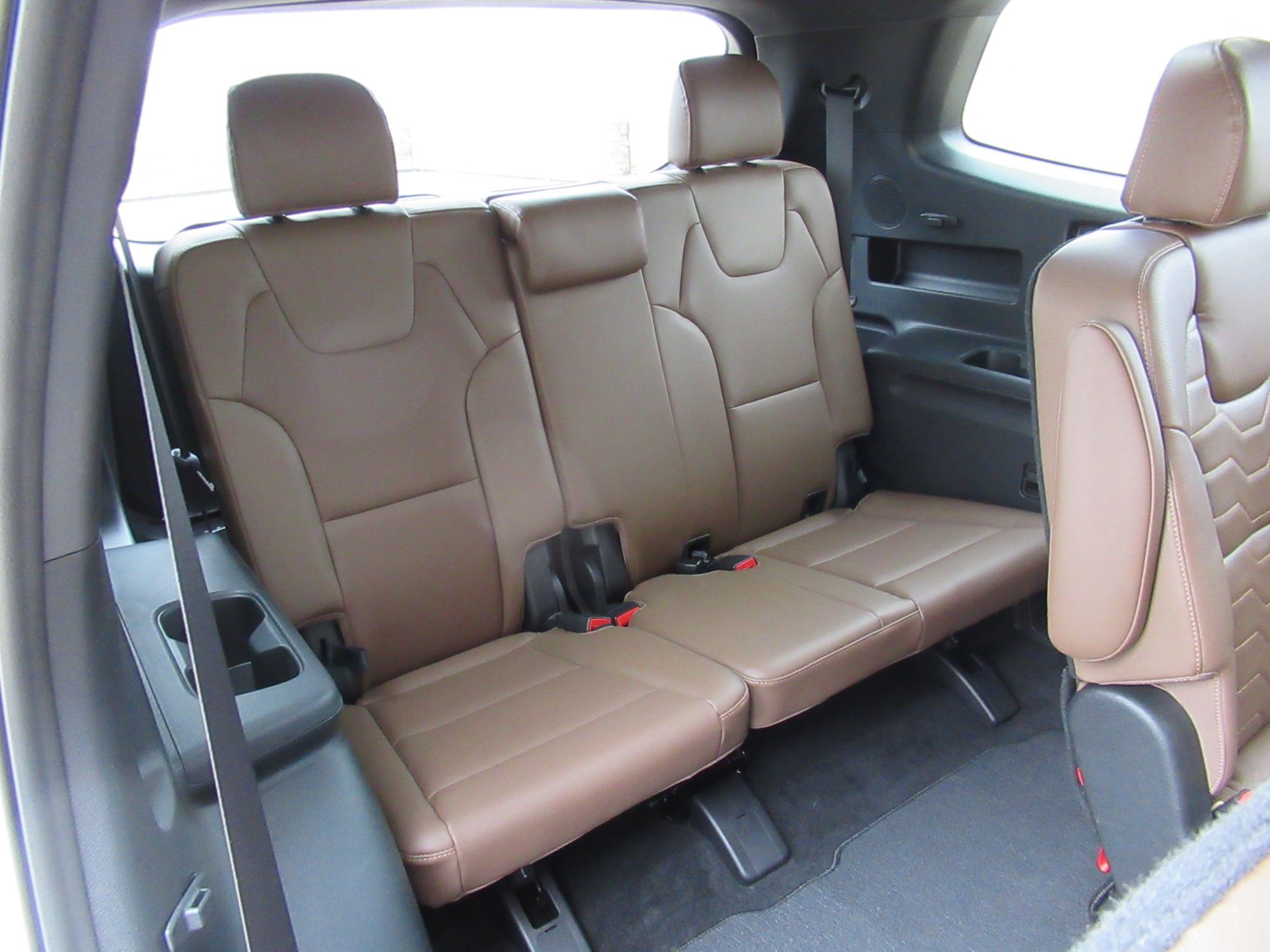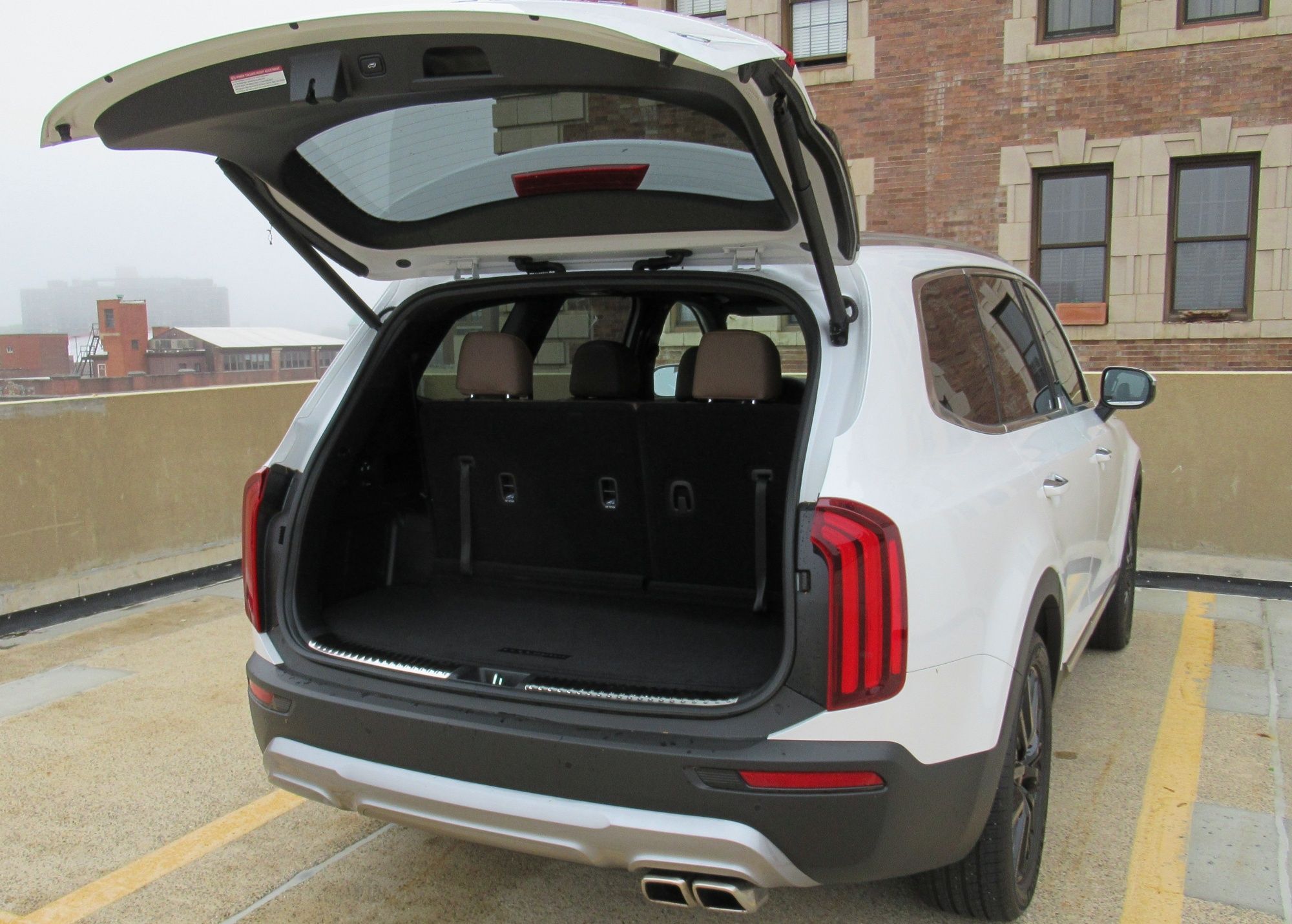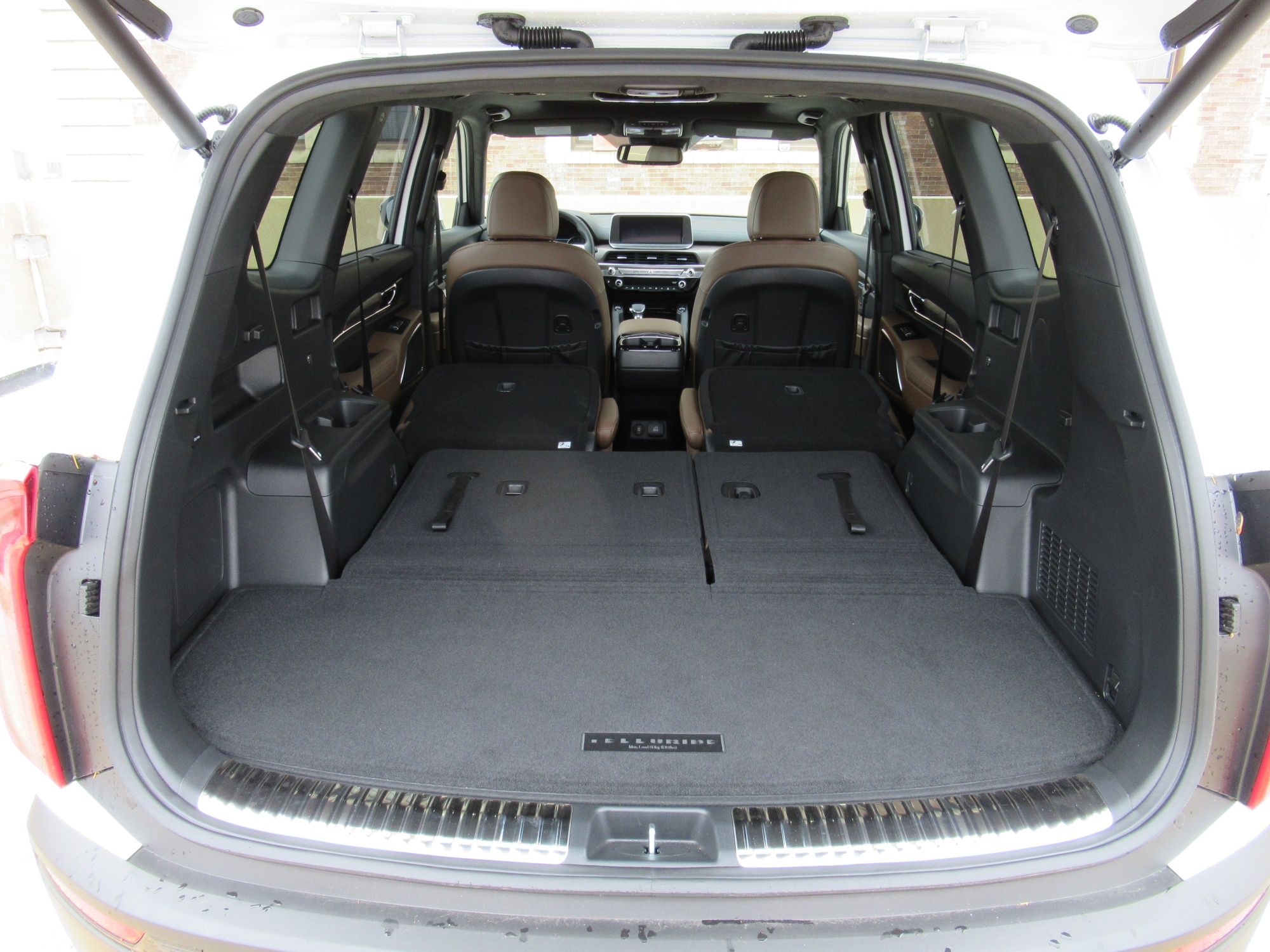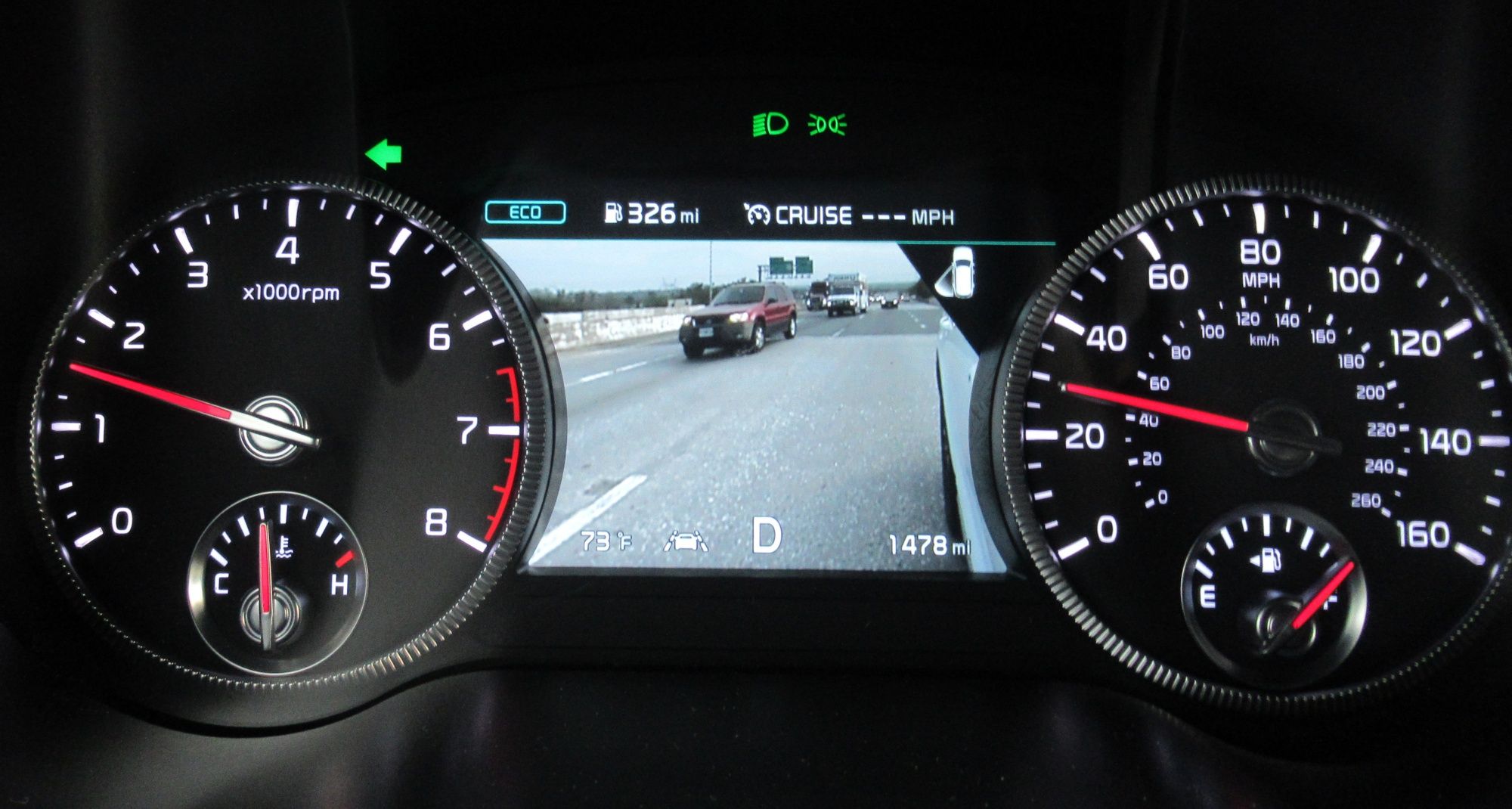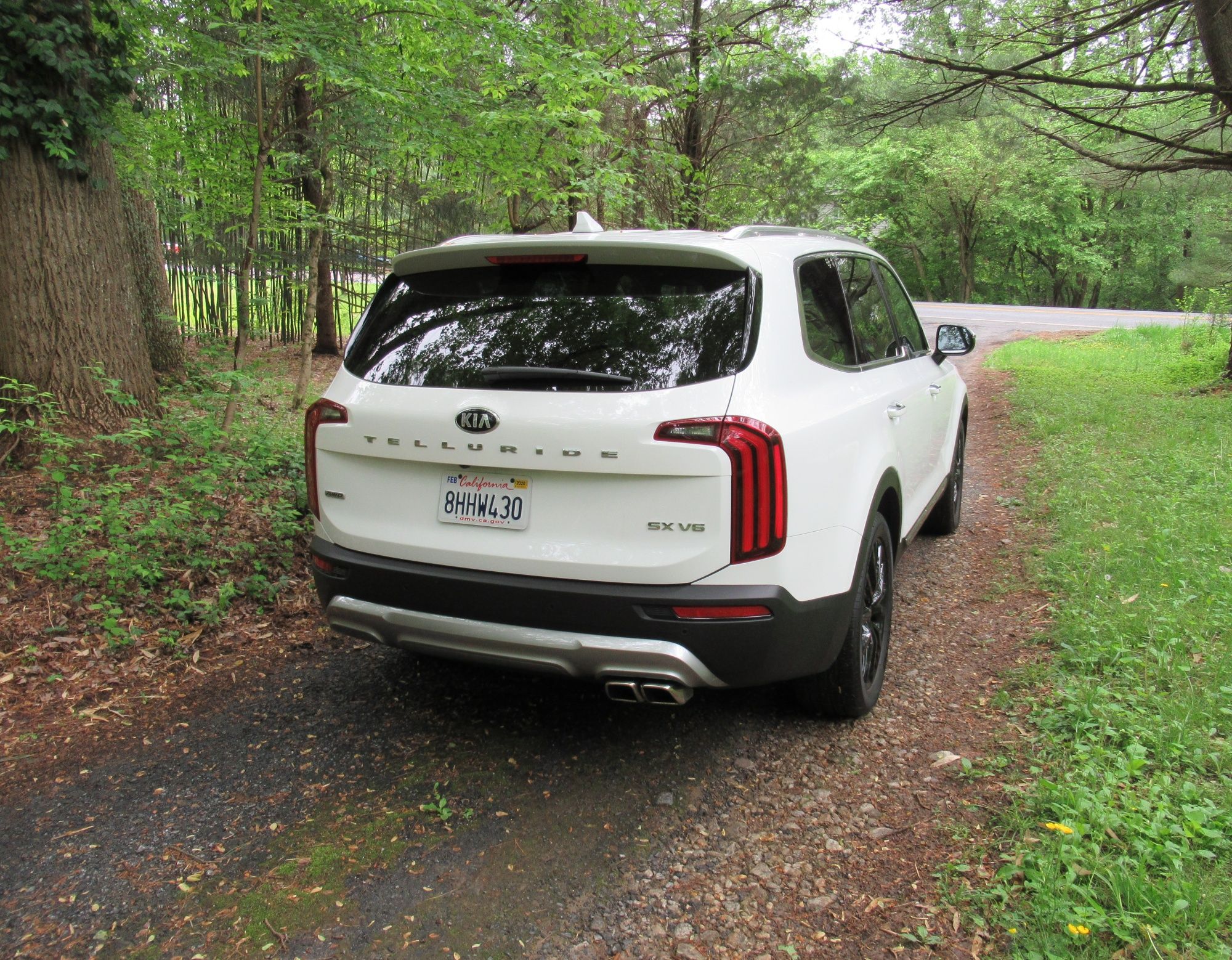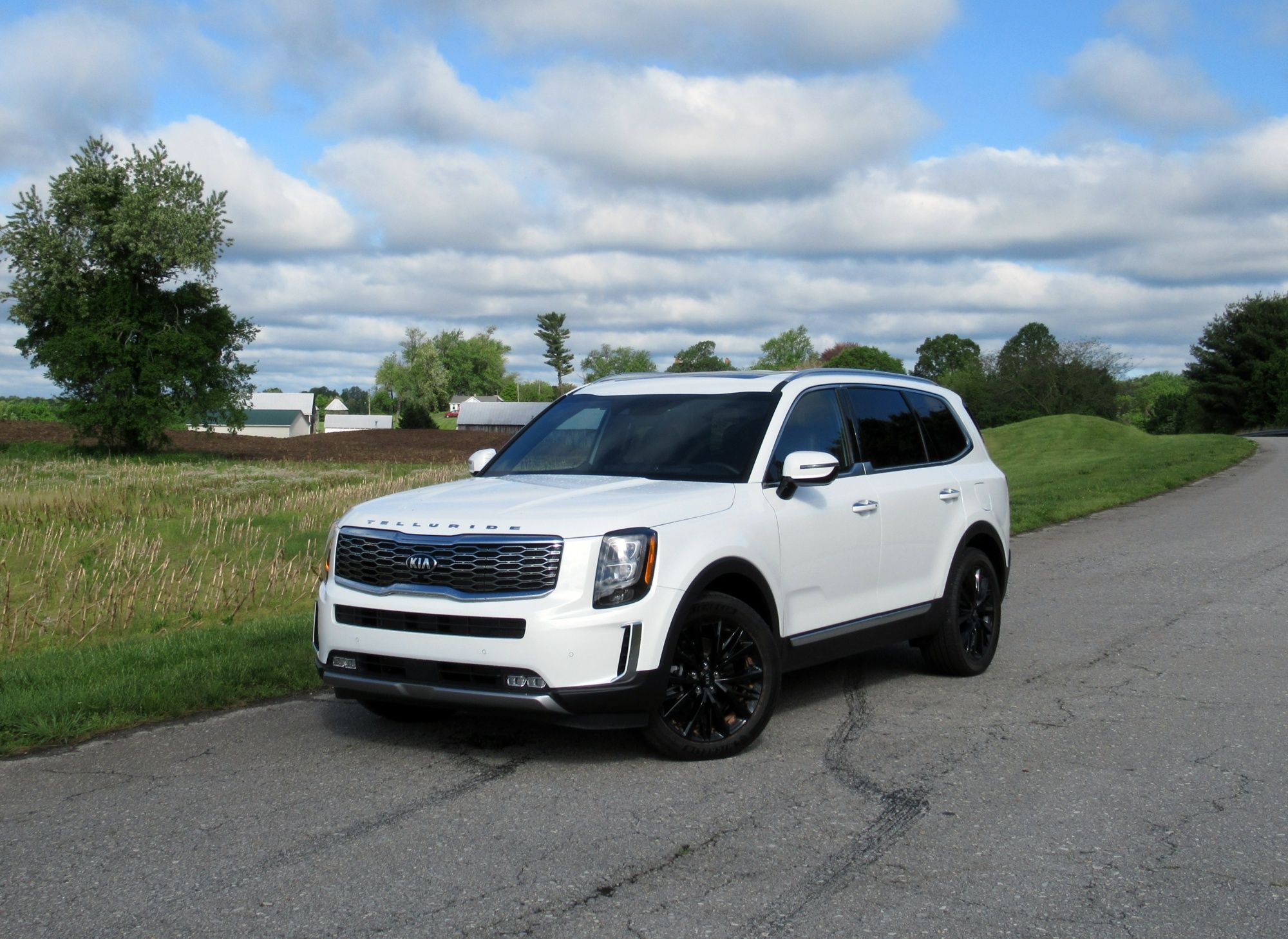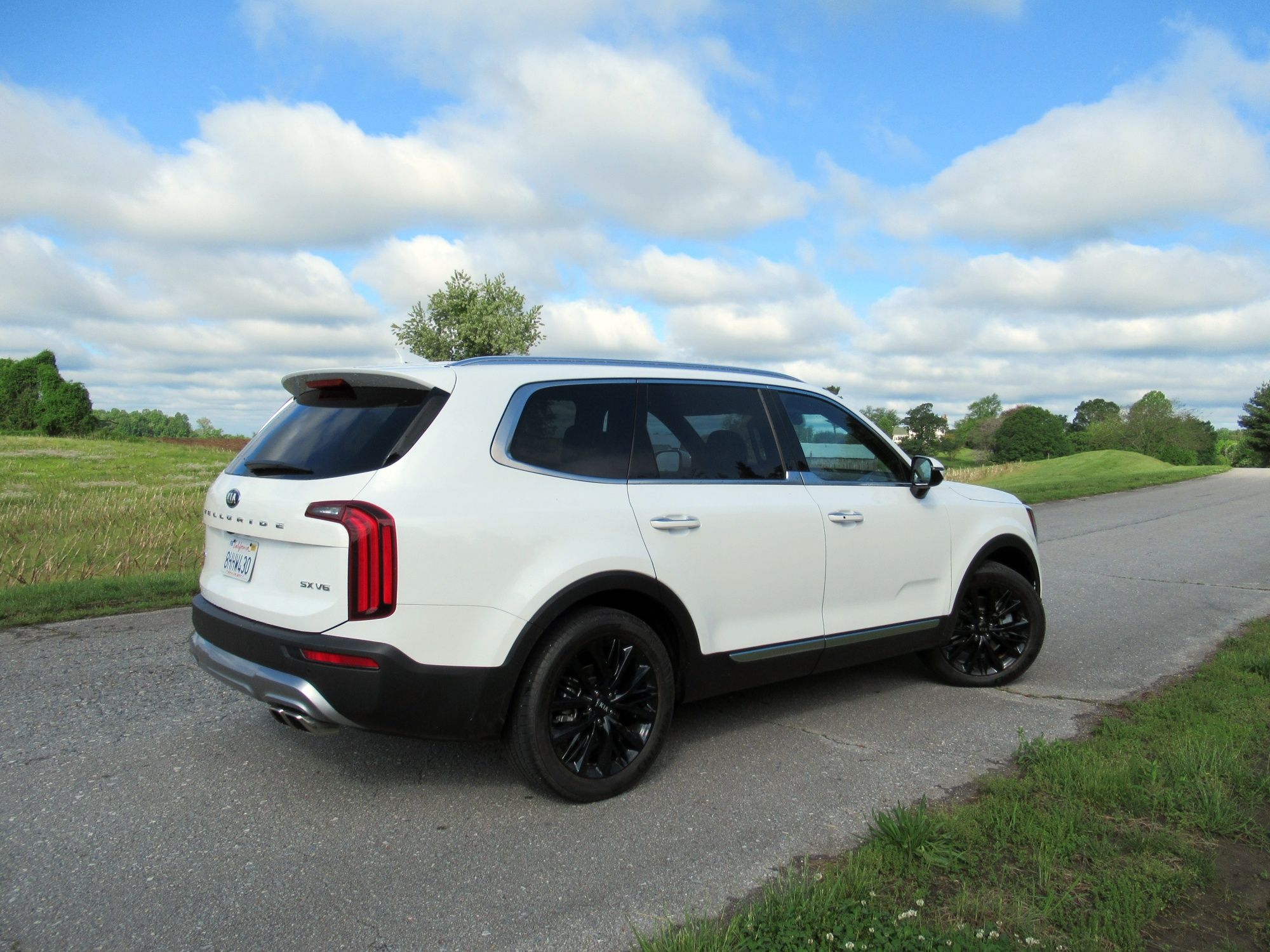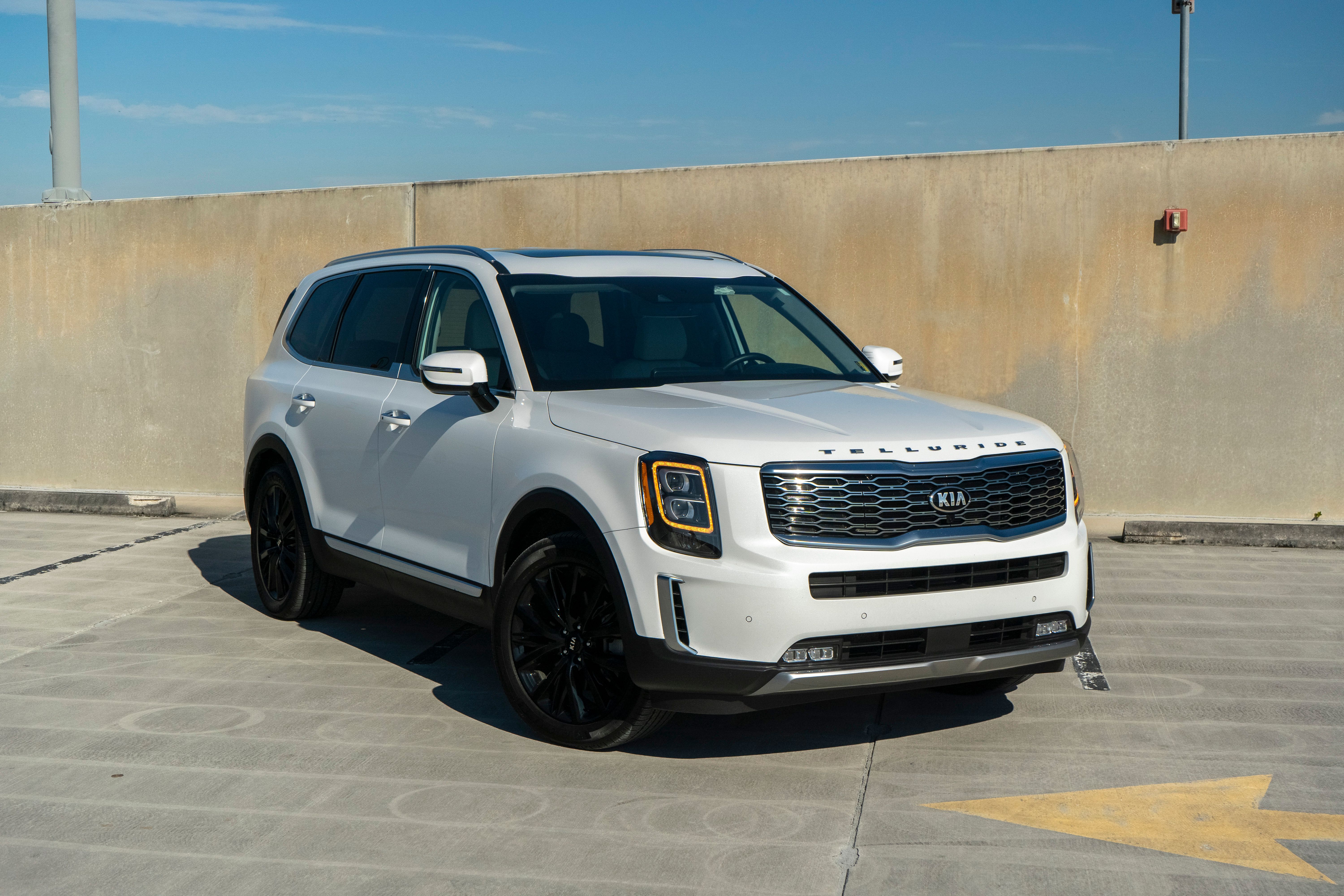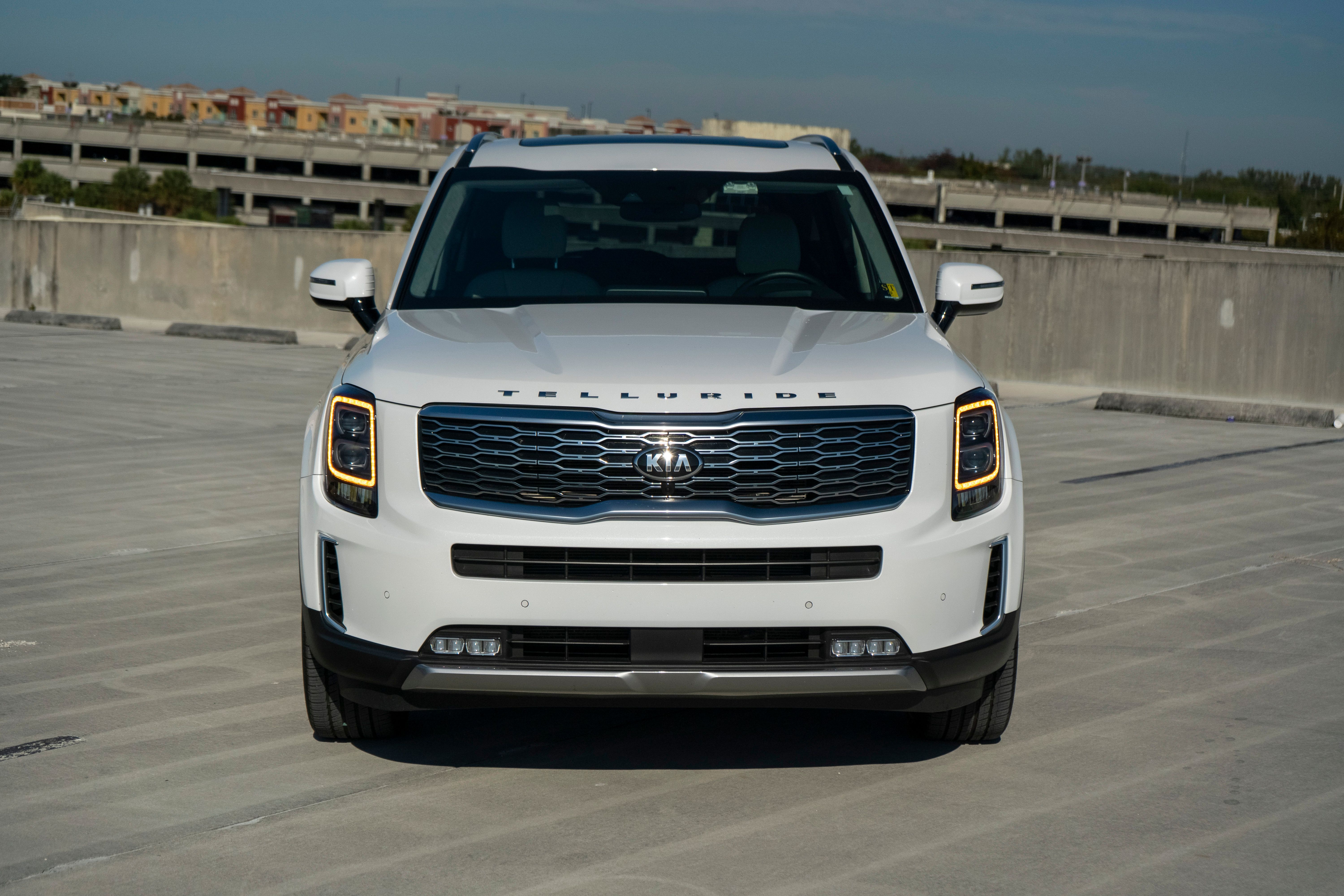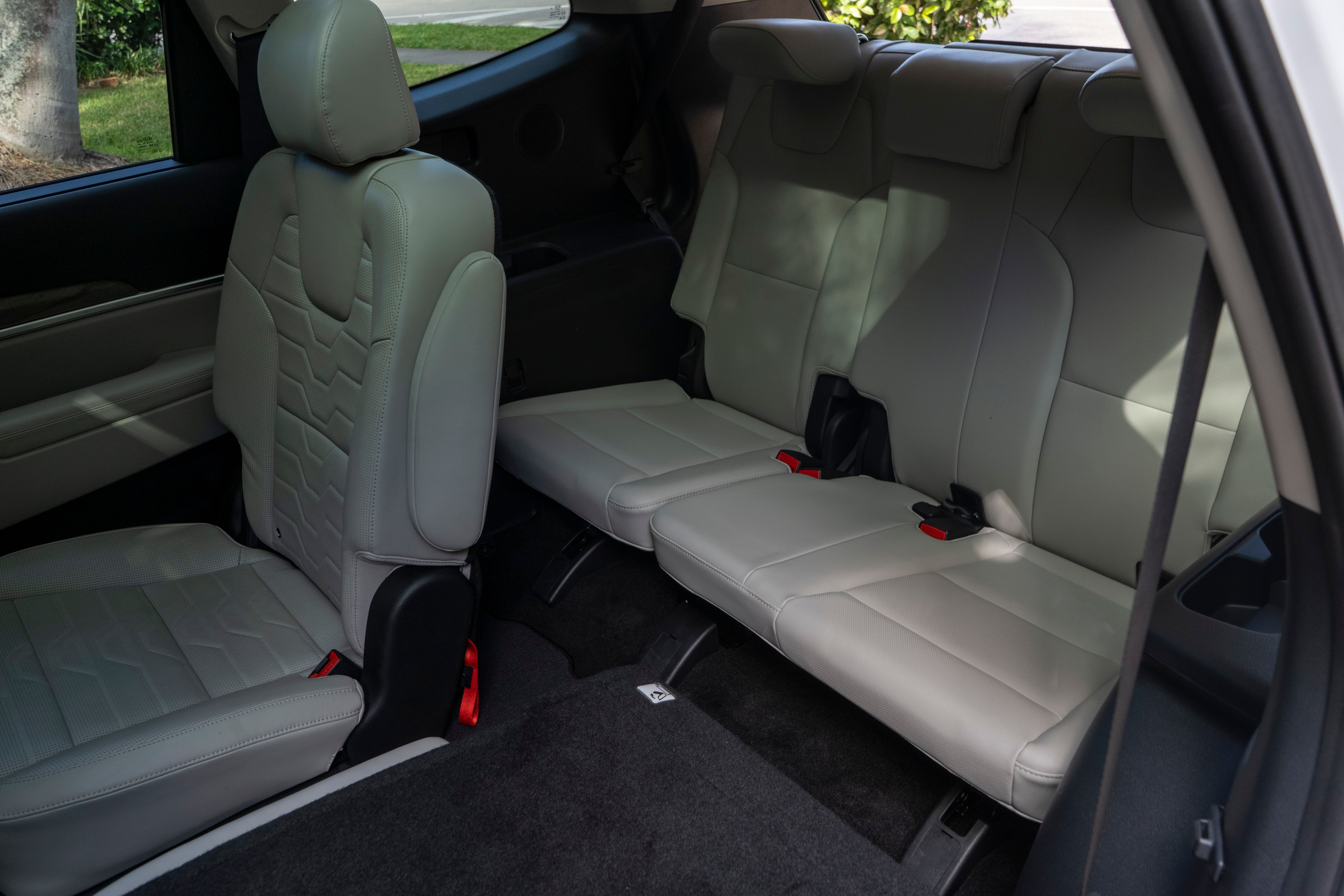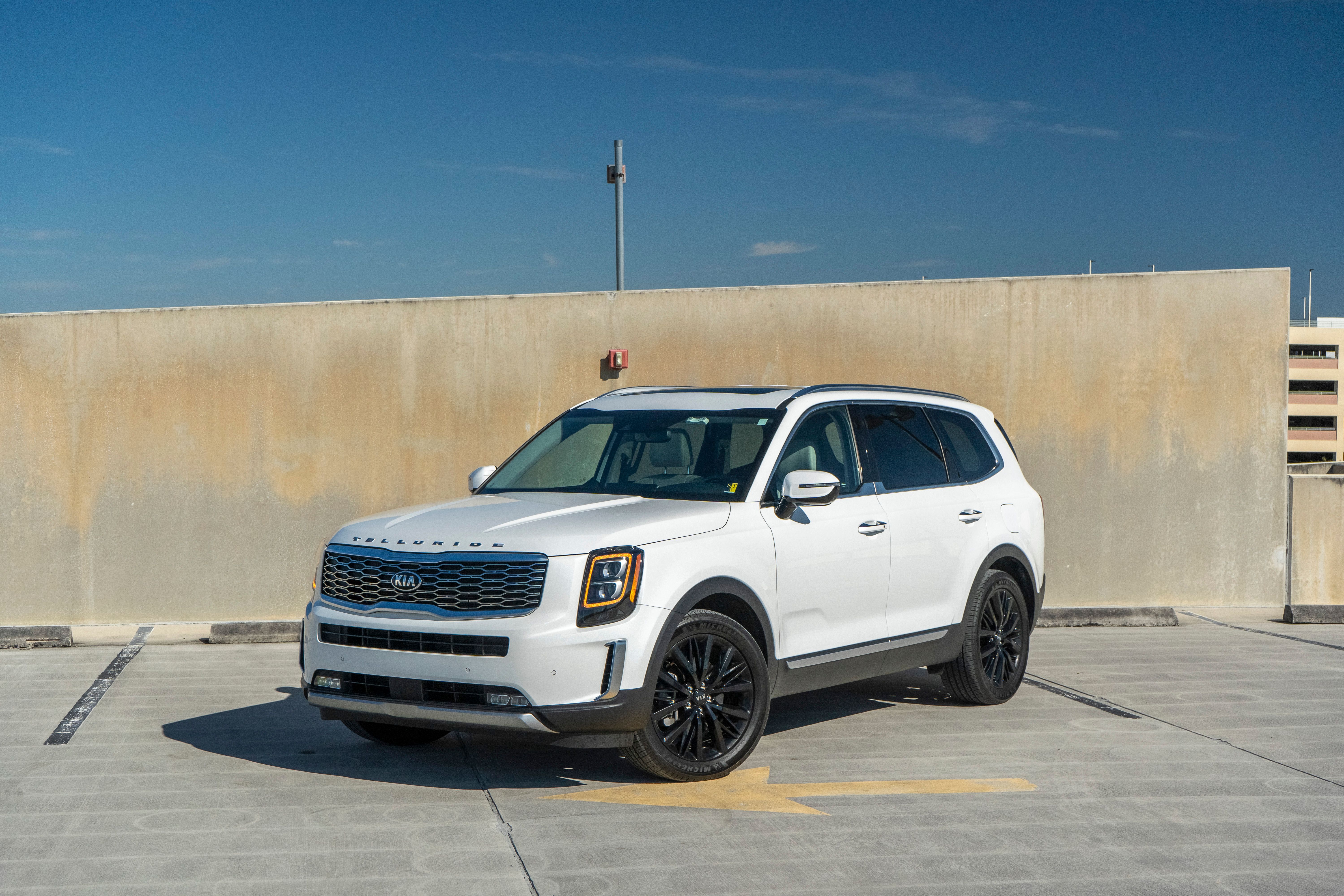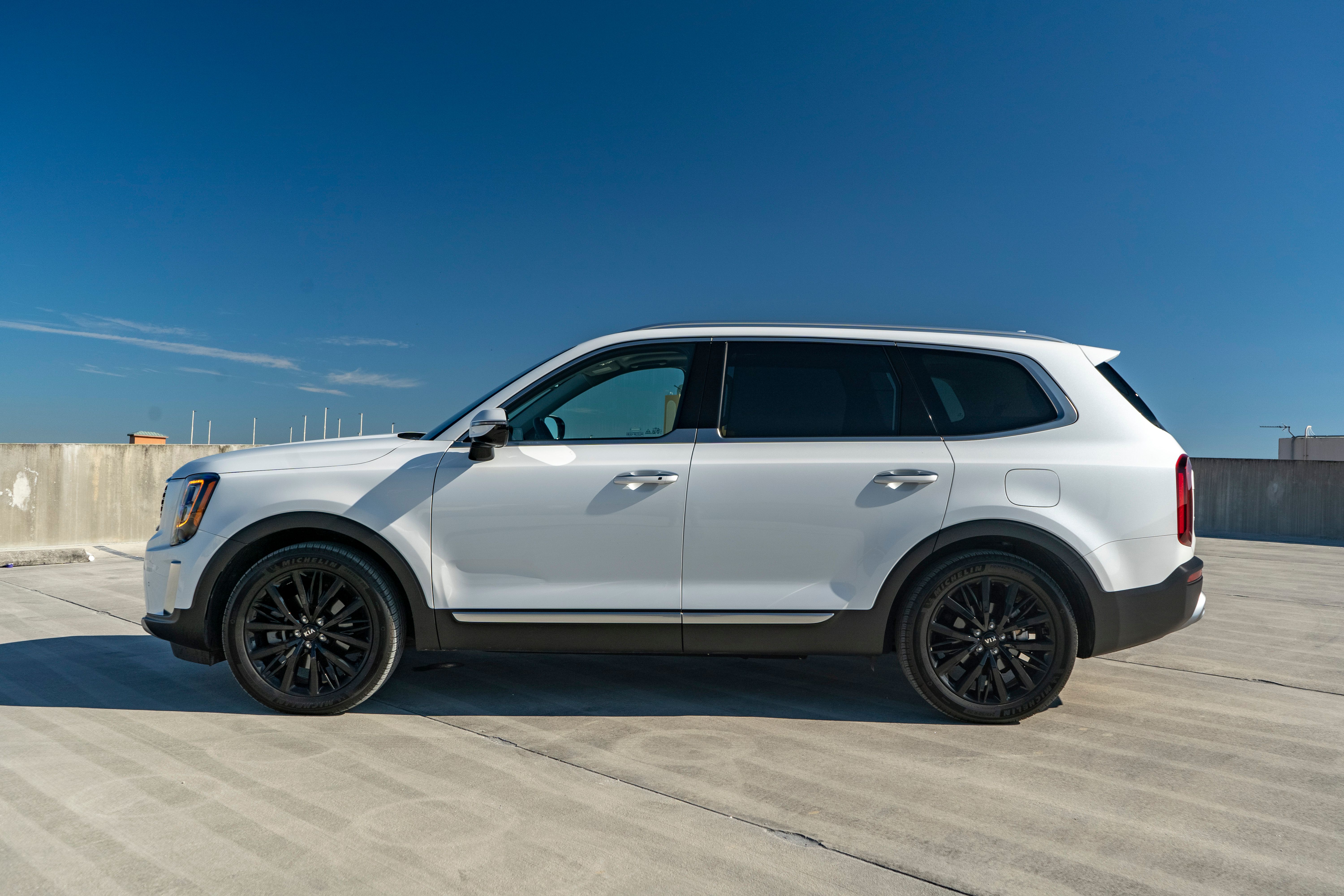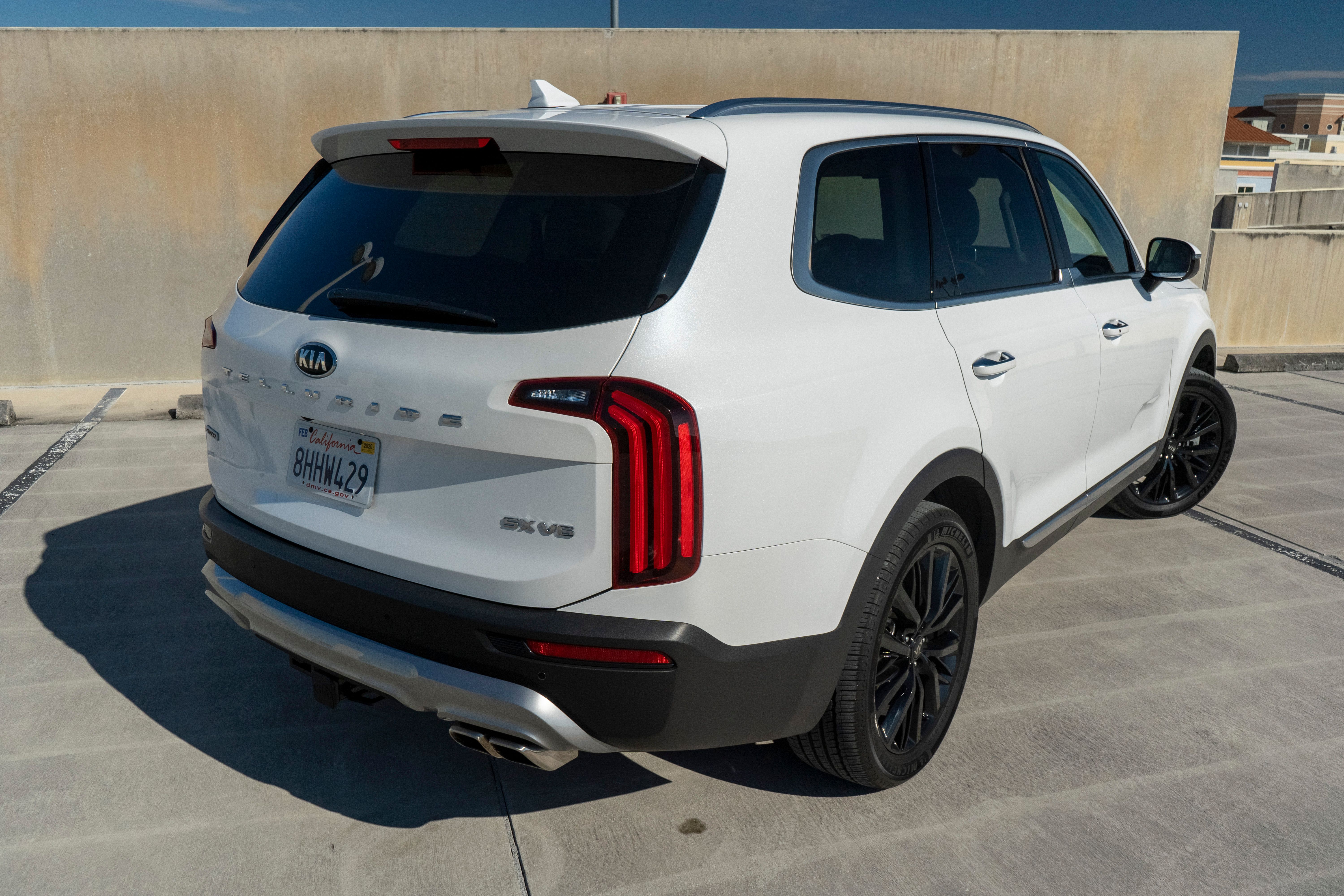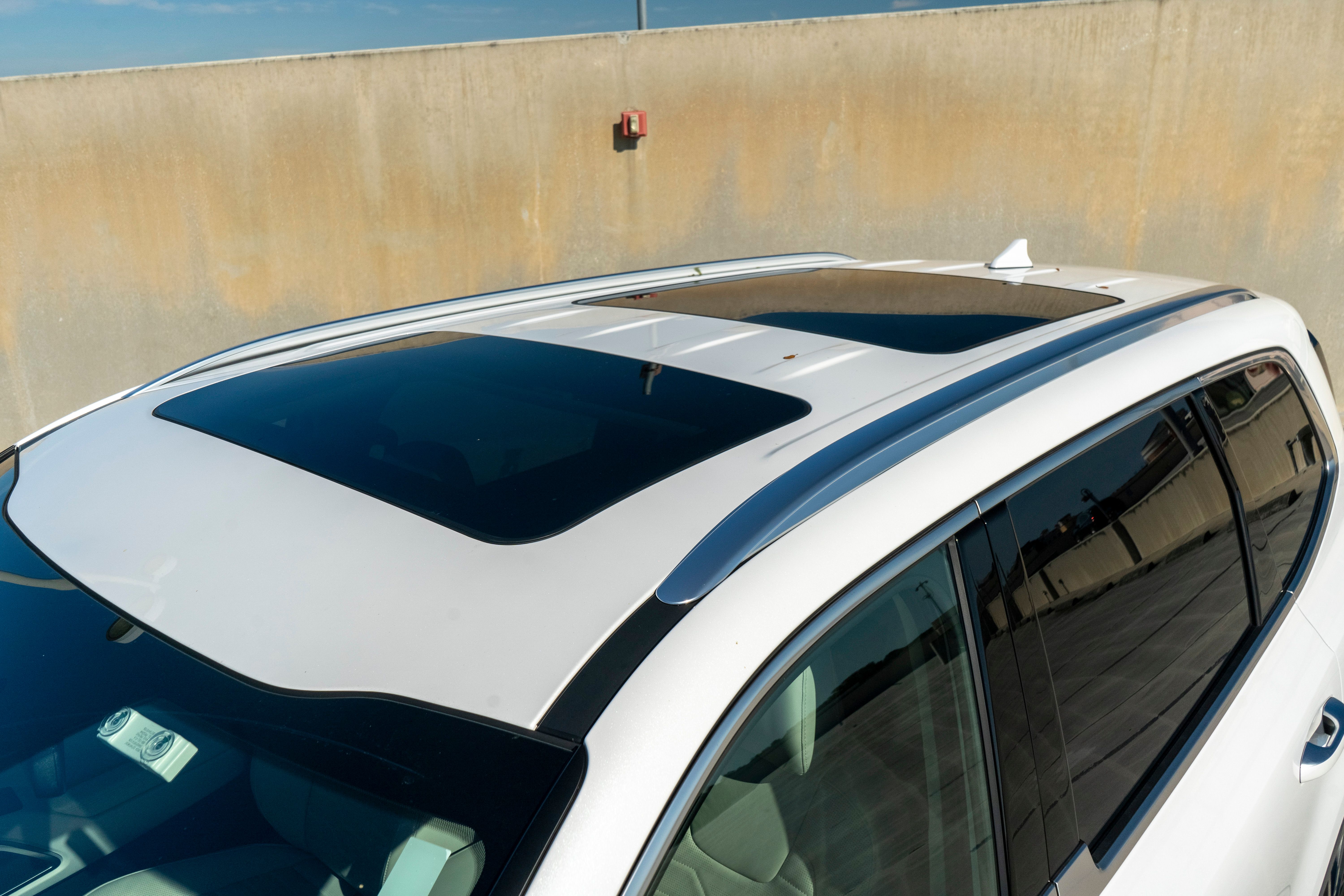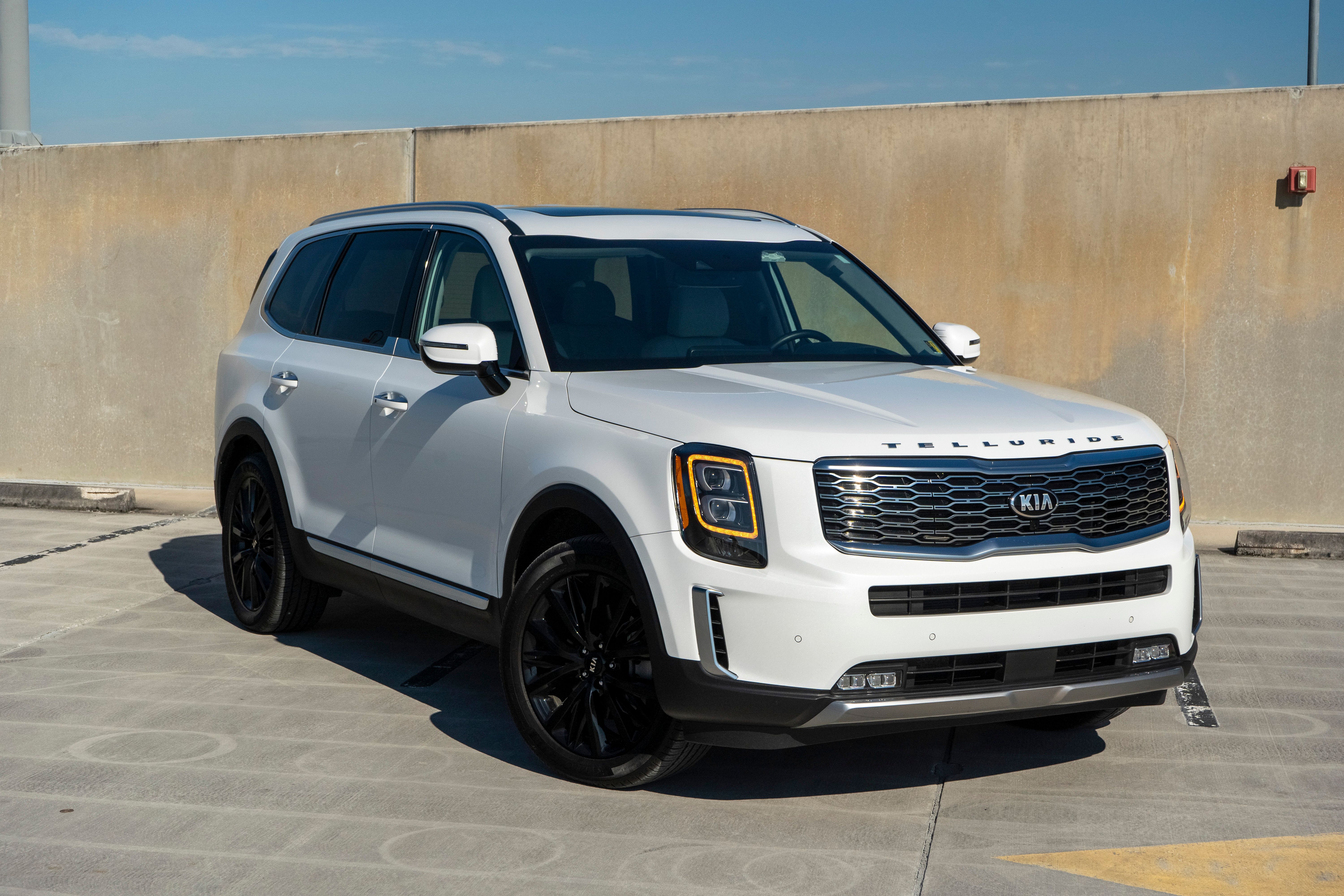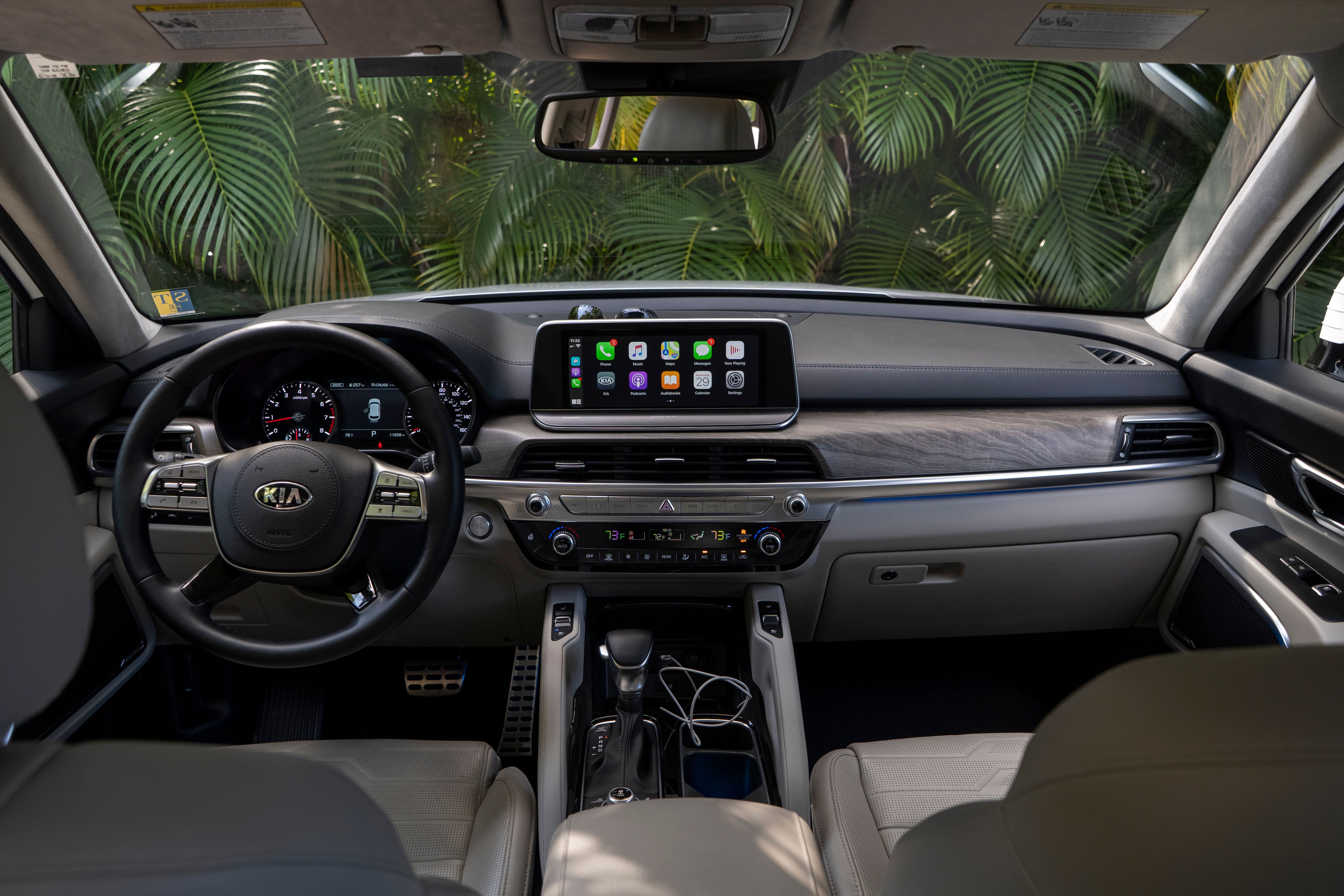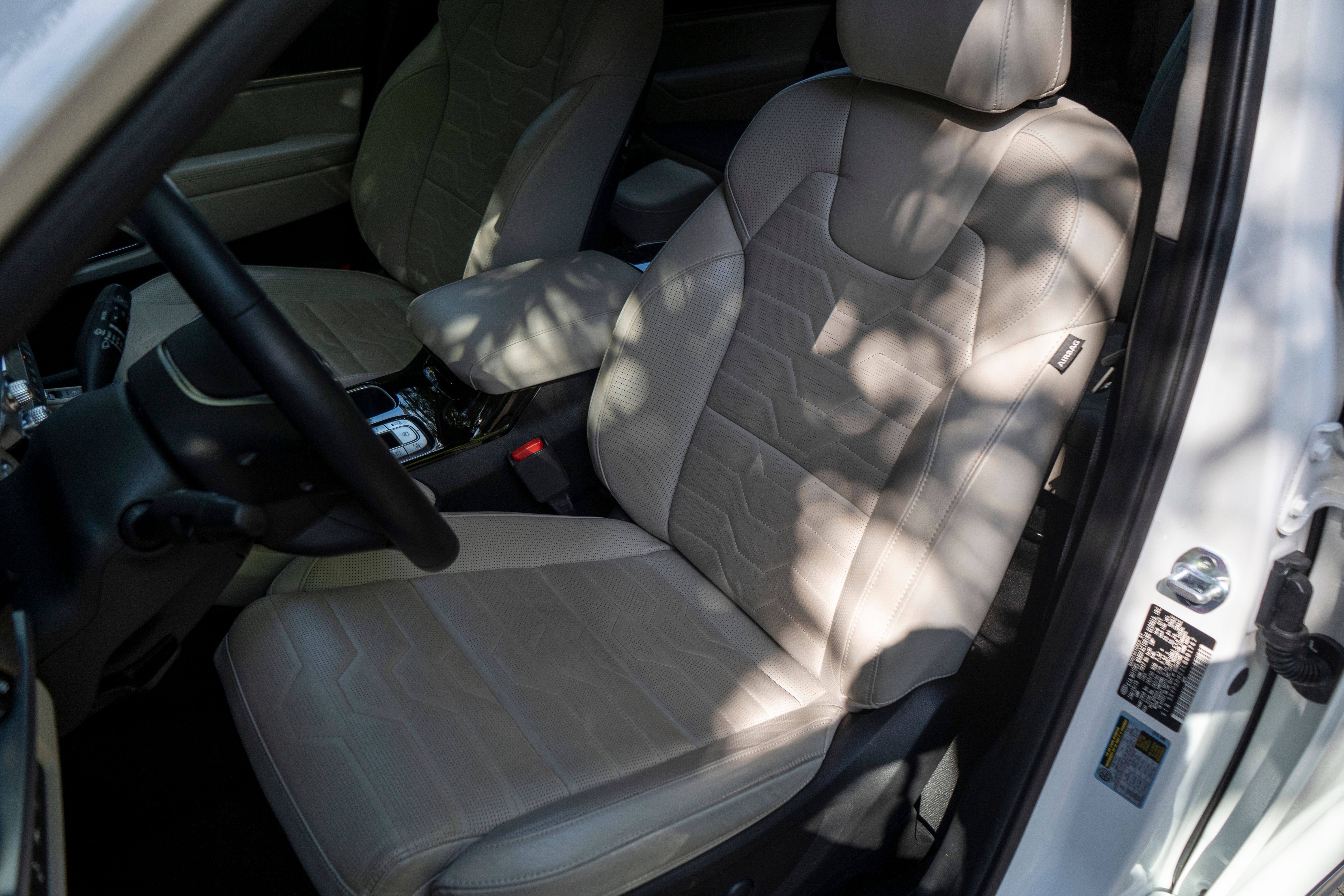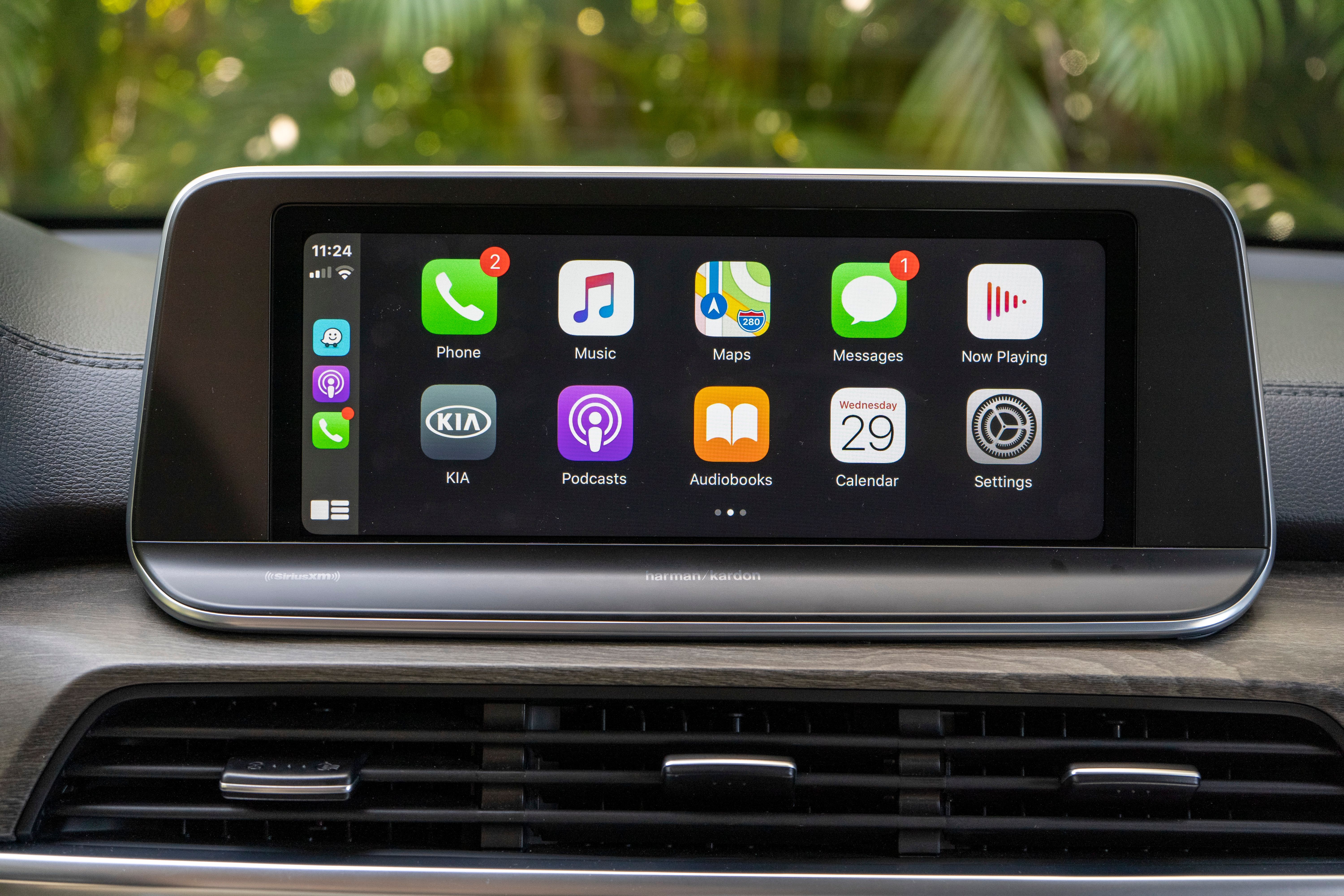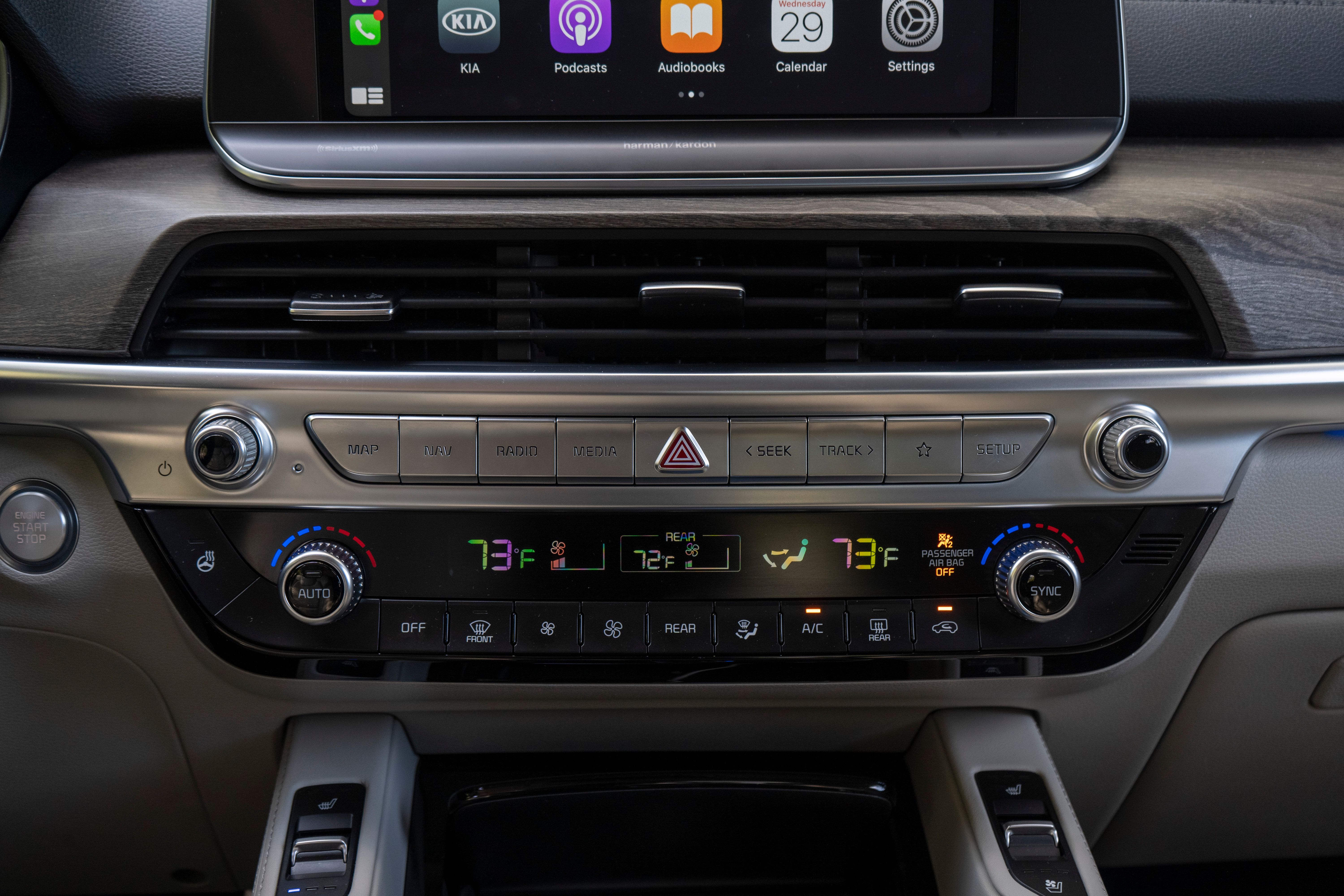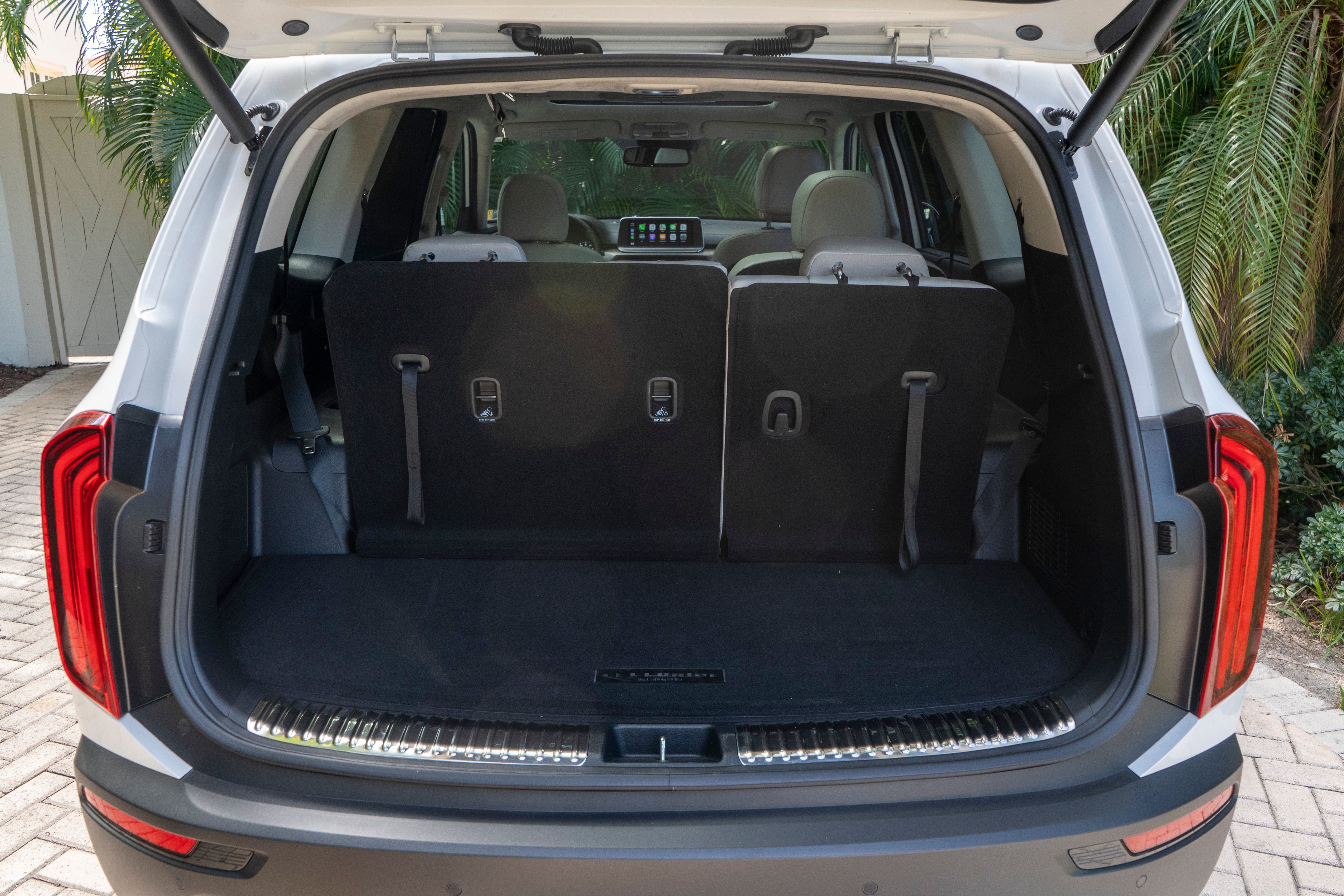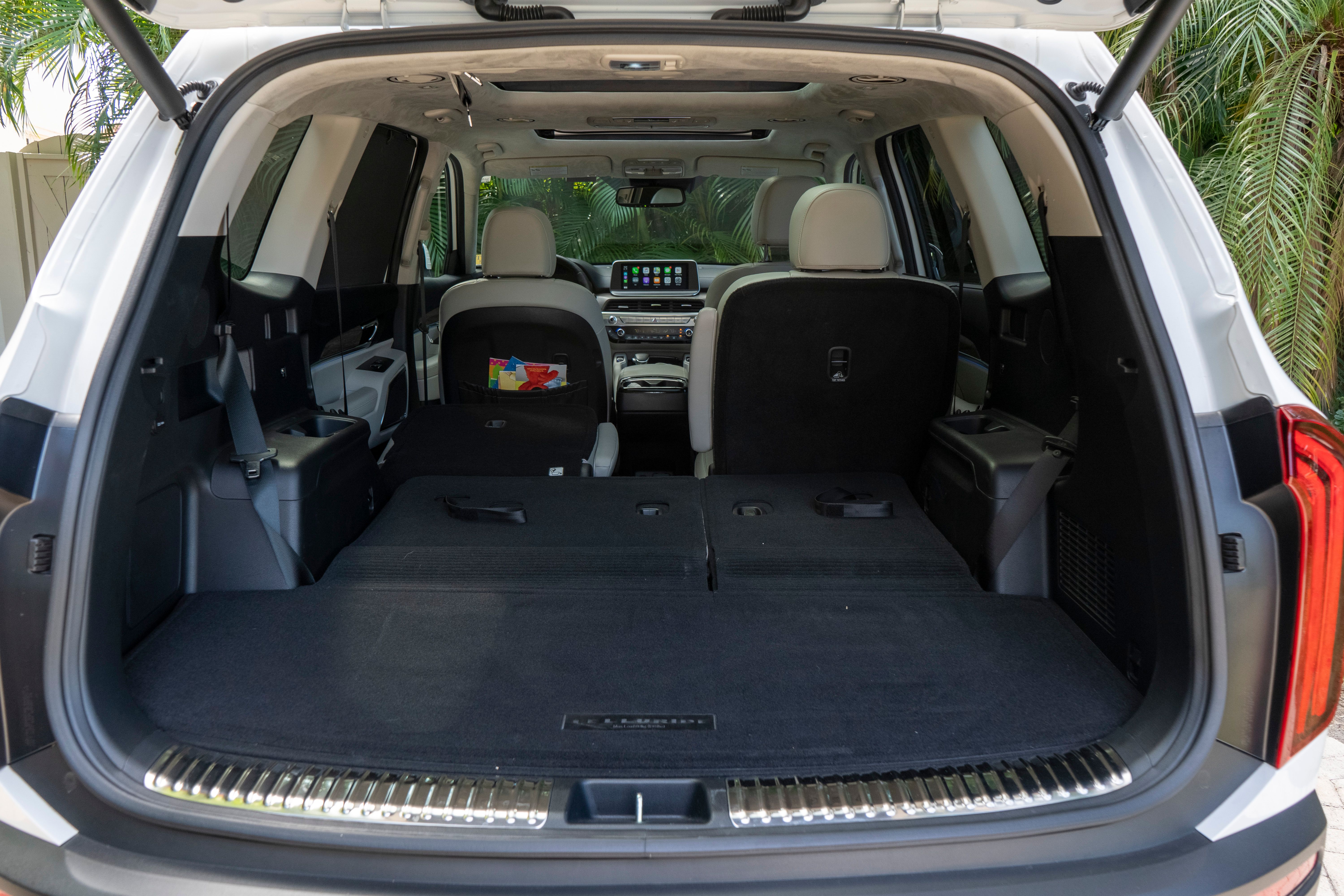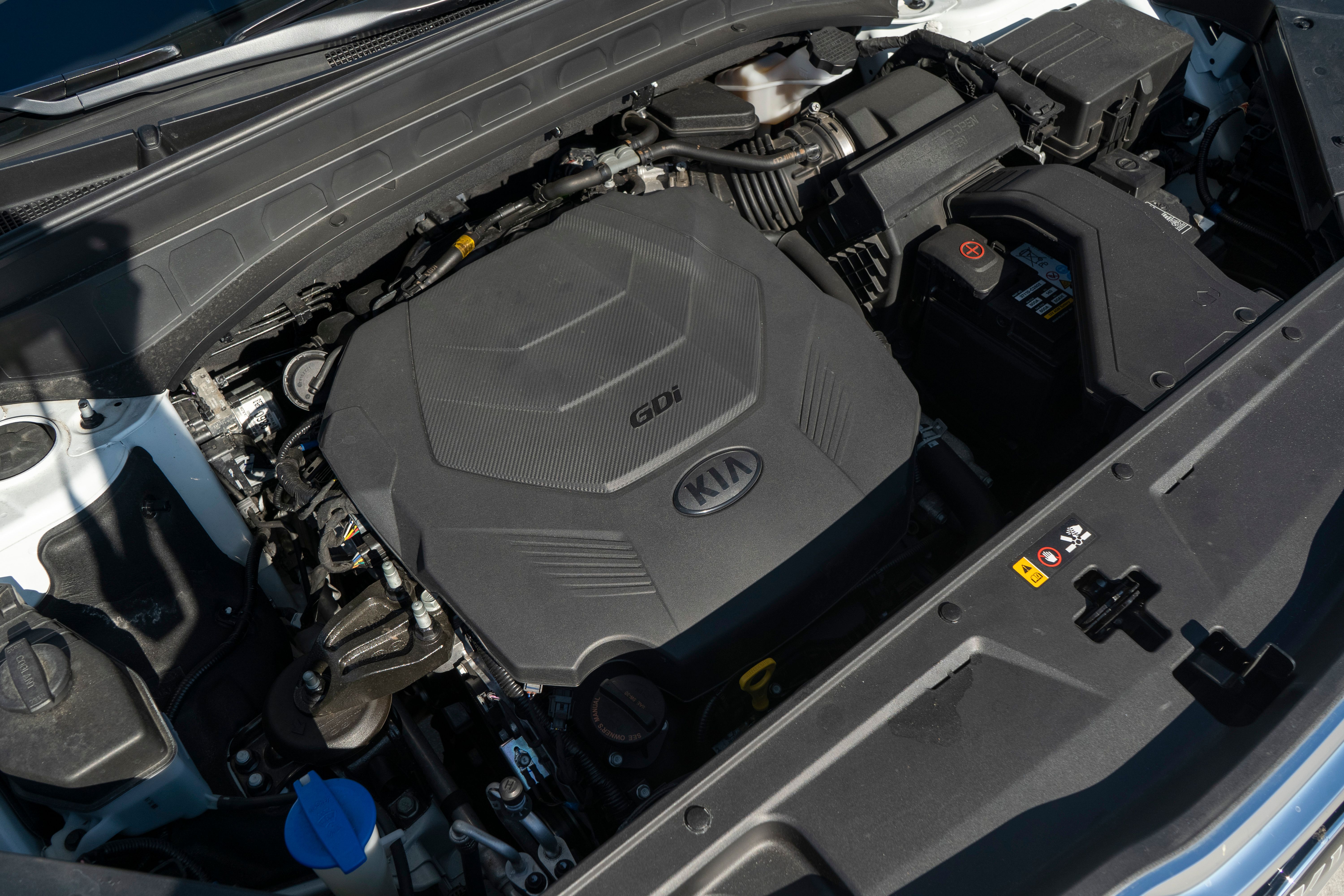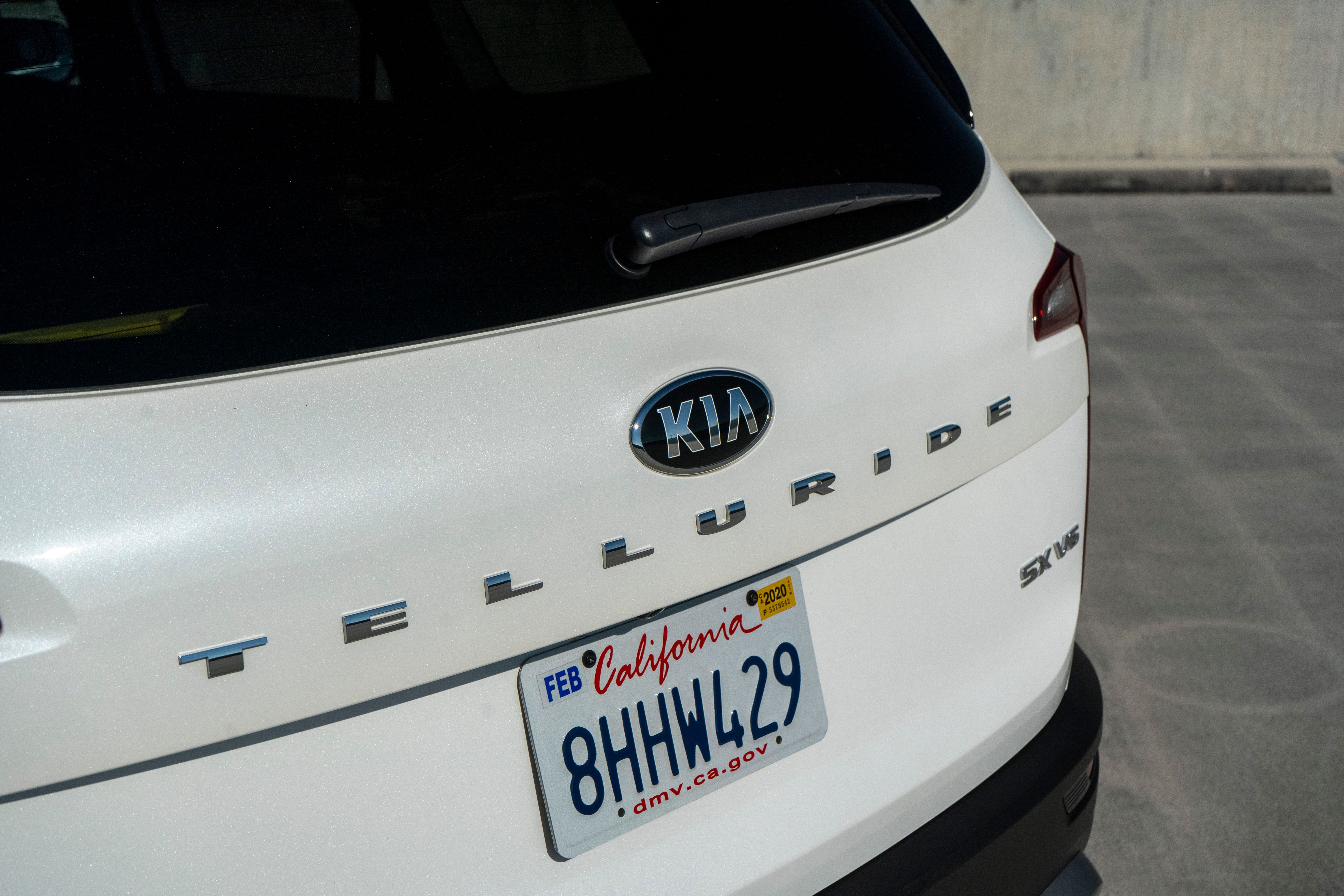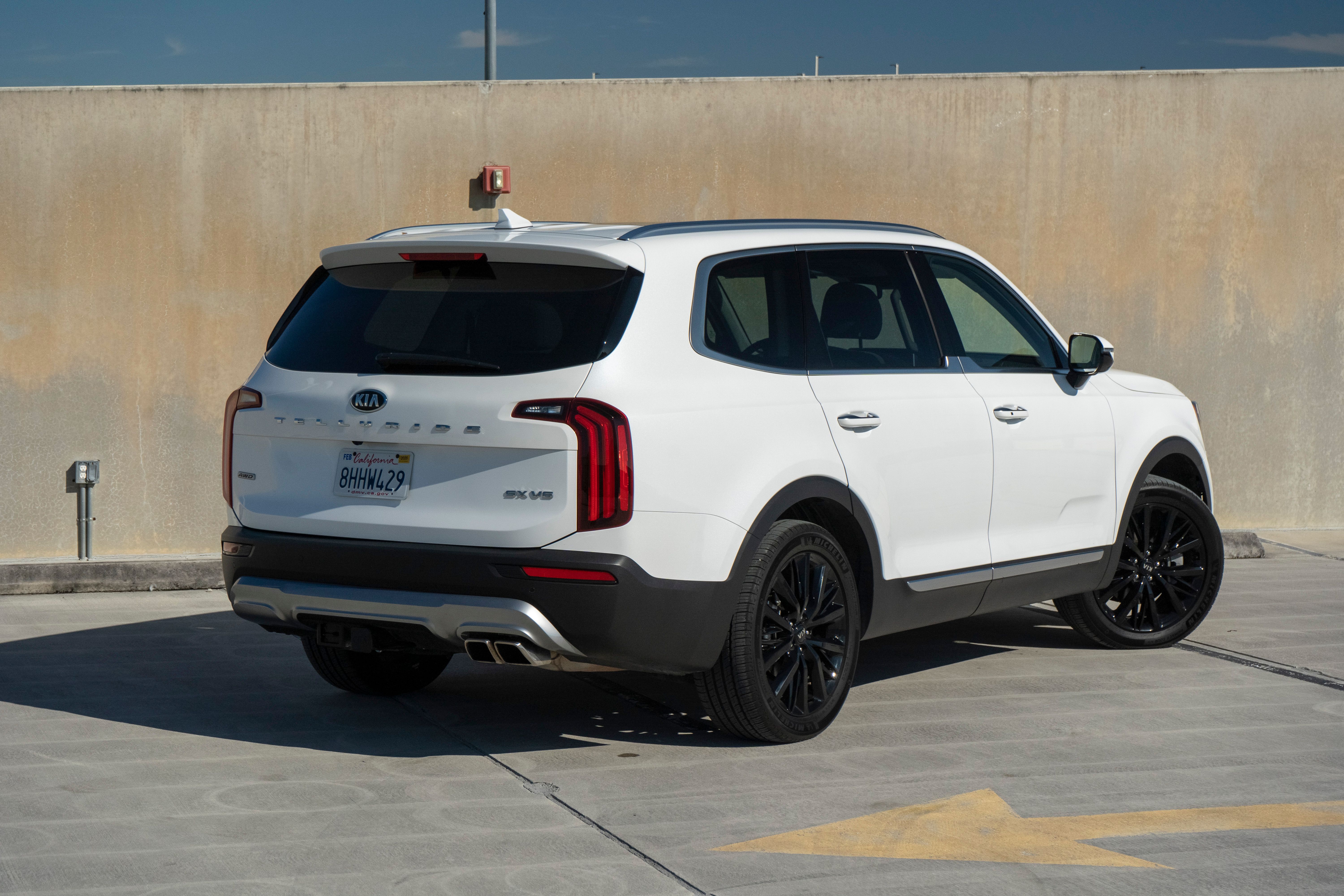As I photographed the 2020 Kia Telluride in a Maryland park, a fellow visitor peeled off from his family to ask about the car. It made sense. Full-size crossovers like the Telluride are the chariot of choice for many families today, thanks to their three rows of seats and long lists of amenities. And the all-new Telluride had just hit the market. But as it turned out, the man wasn’t eyeing the Telluride for himself. It was his teenage daughter who’d sent him across the parking lot to check out this newly released SUV. It looked cool, she told him, kind of like a Range Rover. And she wanted one.
2020 Kia Telluride - Driven
- Make: Array
- Model: 2020 Kia Telluride - Driven
- Engine/Motor: V6
- Horsepower: 291
- Torque: 33
- Transmission: 8-speed auto
Driving Impressions
First off, let me start by saying that our tester was the best Kia has to offer in this segment – the Telleride SX AWD.
Driving the Kia Telluride is an interesting experience. For the most part its nothing short of blissful to drive. The steering is precise, and the transmission is as smooth shifting as they get. The 291-horsepower engine is plentiful enough in terms of power for normal day-to-day use, so unless you’re expecting to drive it with spirit all of the time, you shouldn’t find yourself wanting for more power. We sure didn’t. The engine isn’t exactly responsive at slower speeds, though, as there is a slight lag between the time you put the hammer down and the time the engine actually kicks in. This doesn’t seem to be an issue during overtake maneuvers, though.
However, as is the case with most vehicles in the sub-premium side of this segment, nothing is perfect. During our week with the Telluride, we noticed that there is some understeer to compete with at higher speeds (going back to the notion of near-spirited driving) while there is some body roll at higher spends in sharper bends. To be honest, the Telluride feels quite confident and planted at normal day-to-day city speeds, but when you get up to highway speeds and need to perform quick maneuvers or take an off-ramp a little too quick, the Telluride starts to feel a little top heavy. In most cases, though, handling is on the finer side of confident, just not perfect.
With handling and body roll in mind, I should point out that it’s not entirely bad. During city driving, the Telluride has a relatively firm ride, but in a good way. Stability control can also be a bit confusing. As part of our testing, we decided to see how the Telluride handled in different situations with the stability control turned off. Most people will simply leave it on, but we don’t like to leave any stones unturned. For the most part, the stability control works just fine, but there was a handful of situations where the system magically turned itself back on after being off for an extended period of driving. It does catch you off-guard, but there’s really not a lot of situations where you’d want to turn it off anyway.
The first and second rows are impressively comforatble, and we found the cabin to be very quiet in all situations. Even when merging or overtaking under high throttle, there’s very little engine noise making its way into the cabin. The same can be said for the suspension system. We took a few trips down some pretty rough roads and the cabin noise was rather subdued as well. We did pick up on a little wind noise with both sunroofs open, but that’s a pretty common thing as well, so nothing to really complain about here either. In the end, the Telluride is a comfortable, good-driving, midsize SUV, and it certainly feels like it’s going to give the competition a run for their money.
Exterior Design and Impressions
The Kia Telluride might share a lot of its bones with the Hyundai Palisade, but there’s a reason it took Kia a year to put the Telluride on the market. Outside of the mechanical bits under the skin, the Telluride is significantly different from the Palisade. It did borrow some styling from the Telluride Concept, but the entire front end was changed before it went into production. Now, it sports a muhc larger but wider and thinner grille. Despite the large grille, it’s not overally gaudy or intrusive as, outside of the centerpiece, it’s pretty tame. The small air damns below the grille, the integrated fog lights, the tall, skinny headlights – they all come together to create one impressively attractive package.
From the front end back, the Telluride is pretty boxy. We can appreciate the slope of the roof toward the rear, but not as much as we appreciate the fact that kia didn’t overdo it. The flat black trim around bottom of the vehicle and the less-than-noticeable wheel arches are all feel carefully thought out. The belt line is very reminiscent of modern Audi SUV design, but thanks to limited use of chrome it still exudes a sense of premium without trying to sit in a class it doesn’t belong in.
From the rear end, you’d swear this was a body-on-frame SUV, but the truth is that it’s not – it’s entirely unibody construction. 10 years ago, this rear end design would be frowned upon but today it’s a class-leading look. We particularly like the contour of the taillights and the corresponding matrix inside them. You don’t even notice the reverse lights until you start looking for them, and the slight kink at either end of the rear glass helps emphasize that the greenhouse is just a hair smaller than the lower portion of the body. Normally the mass amount of plastic on the rear fascia would come off as cheap, but thanks to the aluminum insert and trapezoidal exhaust outlets, it all comes together nicely.
Usually, we’re pretty critical of car design, but after Kia’s last attempt at a big SUV – the Borrego that failed miserably – Kia really needed to knock it out of the park. Going into the design process with the experience of failure clearly went along way here.
2020 Kia Telluride exterior dimensions
|
Length |
196.9 |
|---|---|
|
Width |
78.3 |
|
Height |
69.3 |
|
Wheelbase |
114.2 |
|
Approach Angle |
17 Degrees |
|
Departure Angle |
20.9 Degrees |
|
Ground Clearance |
7.9 |
|
Front Track |
67.2 |
|
Rear Track |
67.6 |
Kia Telluride Interior Impressions
At 196.9-inches long, 78.3-inches wide, and 69.3-inches tall, the Telluride sits nicely in the midsize SUV segment. In comparison to the Honda Pilot and Volkswagen Atlas, the Telluride is nearly equal in all categories. The VW Atlas is a bit longer and has a longer wheelbase than both the Pilot and Telluride, but every other dimension is within an inch – these are diehard competitors through and through. So, while the Telluride is the largest vehicle that Kia has ever made, but it’s far from being the largest on the market.
In terms of garage storage, you definitely need something larger than your traditional one-car garage. At least a 1.5-car garage is necessary and a two-car would be even better. The same can be said for both the Pilot and the Atlas, though, so if you’re shopping in this segment, you probably already know that.
|
Length |
196.9 |
196.5 |
198.3 |
|---|---|---|---|
|
Width |
78.3 |
78.6 |
78.3 |
|
Height |
69.3 |
70.6 |
70 |
|
Wheelbase |
114.2 |
111 |
117.3 |
|
Approach Angle |
17 Degrees |
19.7 Degrees |
20.4 Degrees |
|
Departure Angle |
20.9 Degrees |
20.8 Degrees |
22.4 Degrees |
|
Ground Clearance |
7.9 |
7.3 |
8 |
|
Front Track |
67.2 |
66.3 |
67 |
|
Rear Track |
67.6 |
66.3 |
68 |
Kia Telluride Engine, Fuel Economy, Performance, and Towing
The interior of the Kia Telluride is, well, pretty impressive. It has a premium ambiance to it that’s certainly well above its class in terms of pricing. This is true for the range-topping SX AWD trim, the model we tested. As the range-topper, it has all the bells and whistles from the 10.25-inch horizontal touch screen display to the Captain’s chairs in the second row and built-in 110V power inverter. We were surprised to find that even the second row had headed seats and integrated sunshades, and that Harman Kardon audio system definitely adds to that premium ambiance inside the cabin. With the seats wrapped in Nappa leather, and the various bits of aluminum and stainless steel (pedals included, here) it’s hard to forget that you’re in a model that sits just barely over the $40,000 mark and comes from an automaker that was once known for building econoboxes.
However, we’re not talking about a BMW or Mercedes here, so there are still things to remind you that the Telluride isn’t from that neck of the woods. The front driver’s seat only features 12 different adjustment zones. The passenger’s seat only offers 8. That wood-grain trim looks pretty cool, but when you touch it, you know its little more than a good simulated synthetic. There are plenty of soft-touch surfaces scattered throughout the cabin, but those are limited to the first and second row. Climb in the third row, if you can fit, and you’ll find that cheap Korean plastic that you expected elsewhere. It’s not a big deal, but it is there and worth noting.
Overall the seating felt comfortable, especially for first and second-row passengers, but the third row is definitely a little cramped. I would definitely feel guilty condemning a full-grown adult to a long trip back there. As is the case with most three-row models, the third row is as plain Jane as it gets, and are so lacking in the style department that it almost feels like it was thrown in as an after thought. That said, the seconds-row captains chairs are definitely worth splurging on if you don’t go for the SX trim as it makes ingress and egress to the second row very easy.
The little bits of technology scattered throughout the cabin is plentiful. The third row of seats can be controlled via push buttons from the cargo area, however, there are no manual controls for this, so if there is a failure somewhere, you’re stuck with the seats in a set position. Front passengers have access to a wireless charger, although, we generally stuck with USB charging as it was faster and, honestly, more convenient. 12-Volt socekets and USB ports are readily available to most passengers (third-row occupants have a 12-Volt socket in the cargo area) but as a driver, the Apple CarPlay and Android Auto seemed to work flawlessly.
2020 Kia Telluride vs competitors interior dimensions
|
Front Headroom |
40.9 |
40.1 |
41.3 |
|---|---|---|---|
|
Front Shoulder Room |
61.6 |
62 |
61.5 |
|
Front Leg Room |
41.4 |
40.9 |
41.5 |
|
Middle Headroom |
40.2 |
40.2 |
40.3 |
|
Middle Shoulder Room |
61.2 |
62 |
60.8 |
|
Middle Leg Room |
42.4 |
38.4 |
37.6 |
|
Rear Headroom |
38.1 |
38.9 |
38.3 |
|
Rear Shoulder Room |
53.3 |
57.6 |
54.9 |
|
Rear Leg Room |
31.4 |
31.9 |
33.7 |
|
Total Interior Volume |
178.1 cu-ft |
152.9 cu-ft |
153.7 cu-ft |
Kia Telluride Towing Capacity
We have to give Kia kudos in terms of how well the Telluride’s infotainment system works. It’s quick to use, the menu structure is simple, and pairing your phone is a breeze. On a personal note, we were really a fan of the wide and short design as if it had been taller, it would have made navigation a little easier to see and work with.
Fortunately, Kia engineers were smart enough to put physical buttons for the system in the center stack, so just below it, you’ll find a set of knobs and a handful of other controls. Most of these are for simply controlling volume or navigating menus, but we found them a little more intuitive to use than reaching for the touchscreen display all of the time. Overall, the system is simple enough that most drivers, young and old, should be able to get the hang of it quickly, especially if they have just basic experience with a modern-day smartphone.
Kia Telluride Fuel Economy
The Kia Telluride offers up a minimum of 21 cubic-feet of cargo room, with the maximum figure – with all the seats folded forward – being 87 cubic-feet. The minimum figure beats out the Honda Pilot at 16.5 cubic-feet and the Volkswagen Atlas, but both models beat out the Telluride with the third-row folded down. In terms of maximum cargo, the Telluride bests the Pilot by a little of 3 cubic-feet but the Atlas offers nearly 10 cubic-feet more with all of its seats folded.
Here’s the thing, though. Kia paid special attention to providing as much cargo room as possible in general, but with the second-row captain’s chairs, you don’t get a comletely flat floor. Both second-row captain’s chairs are tilted upward at around 15-degrees, and it’s generally not a big deal, but it can make organized loading a bit of a paid. Furthermore, there’s a weird dip in the floor between the main cargo area and the back of the third row, something could could have been easily avoided. GMC, for instance, has been installing a small plate at the bottom of the rear seatbacks in the Yukon that cover this gap and make for a truly flat floor. Again, not a big deal, but sometimes it’s the little things that count the most.
|
Minimum Cargo Room |
21 |
16.5 |
20.6 |
|---|---|---|---|
|
2nd Row Folded |
46 |
46.8 |
55.5 |
|
Maximum Cargo Room |
87 |
83.9 |
96.8 |
Kia Telluride Pricing
The Kia Telluride is powered by a 3.8-liter V-6 that is good for a reasonable 291 horsepower and 262 pound-feet of torque. Curb weight for the Telluride comes in at somewhere between 4,211 pounds and 4,482 pounds depending on the trim level and equipement. It’s not a light model by any means, but it’s lighter than it would have been had Kia gone with the body-on-frame design, so that uni-body construction actually pays off a bit. During our testing at Top Speed headquarters, we were able to nail the 60-mph sprint in 7.3 seconds and we clocked a quarter-mile in right around 15.3 seconds at 93.1 mph – not bad for a larger, midsize SUV. Shifting, by the way, is handled by an eight-speed automatic transmission.
2020 Kia Telluride drivetrain specifications
|
Engine |
3.8-Liter V-6 |
|---|---|
|
Horsepower |
291 HP |
|
Torque |
262 LB-FT |
|
Transmission |
8AT |
|
Driveline |
FWD \ AWD (optional) |
|
Fuel Type |
Gasoline, Regular |
|
Front Suspension |
Independent |
|
Rear Suspension |
Independent Multi-link |
|
Fuel Capacity |
18.8 Gal |
|
Fuel Economy |
20/26/23 (fwd) 19/24/21 (awd) |
|
Turning Circle |
38.8 Feet |
|
Curb Weight |
4,211 – 4,482 LBS |
|
Towing Capacity |
5,000 Pounds |
Honda Pilot
If you’re someone that’s into towing, you’ll be happy to know that the Kia Telluride can tow up to 5,000 pounds, which is equal to that of both the Honda Pilot and Volkswagen Atlas. That’s enough to haul a reasonable sized trailer, but if you’re someone who tows larger trailers or vehicles, you might want to look for something a bit larger and more capable.
Read our full review on the 2020 Honda Pilot1
Fuel economy is where the Kia Telluride excels against the competition. When equipped with AWD, the Kia Telluride manages 19 mpg in the city, 24 mpg on the highway, 21 mpg combined. Skip the AWD and you’ll have a FWD SUV that can attain 20 mpg in the city, 26 mpg on the highway, and 23 mpg combined. In comparison, these figures either meet or beat the fuel economy of both the Honda Pilot and Volkswagen Atlas:
2020 Kia Telluride vs competitors - fuel economy
|
City |
Highway |
Combined |
Kia Telluride FWD |
20 |
26 |
23 |
|
|---|---|---|---|---|---|---|---|
|
Kia Telluride AWD |
19 |
24 |
21 |
||||
|
Honda Pilot FWD |
19 |
27 |
22 |
||||
|
Honda Pilot AWD |
18 |
26 |
21 |
||||
|
Volkswagen Atlas FWD |
20 |
26 |
22 |
||||
|
Volkswagen Atlas AWD |
17 |
23 |
19 |
Read our full review on the 2020 Volkswagen Atlas0
The Kia Telluride is offered in four different trim levels with rather simplistic pricing. The entry-level LX trim comes in at $31,890 with the Telluride S commanding $34,290 and the Telluride EX hitting the wallet for $37,290. The range-topping SX trim, like the one we tested, has an MSRP of $41,790. Add on all the extras available for the range-topper, though, and you can expect to add an additional $5,930 - bringing the total price up to $47,720. That’s a far cry from the entry-level model, but even without the extras, the SX is very well equipped and worth checking out. See how the Kia Telluride compares to the competition in the table below!
2020 Kia Telluride prices
|
Telluride LX |
3.8L GDI - 8 A/T (FWD) |
$31,890.00 |
|---|---|---|
|
Telluride EX |
3.8L GDI - 8 A/T (FWD) |
$37,290.00 |
|
Telluride S |
3.8L GDI - 8 A/T (FWD) |
$34,290.00 |
|
Telluride SX |
3.8L GDI - 8 A/T (FWD) |
$41,790.00 |
|
Telluride LX |
3.8L GDI - 8 A/T (AWD) |
$33,890.00 |
|
Telluride EX |
3.8L GDI - 8 A/T (AWD) |
$39,290.00 |
|
Telluride S |
3.8L GDI - 8 A/T (AWD) |
$36,290.00 |
|
Telluride SX |
3.8L GDI - 8 A/T (AWD) |
$43,790.00 |
Final Thoughts
Honda Pilot
|
ids=885742,885743 |
no_overlay=false |
before_label=2020 Kia Telluride |
after_label=2020 Honda Pilot> |
The Honda Pilot is another strong contender in the midsize SUV segment, and it seems to excel where the Kia Telluride does not. The Pilot lives its life as a more toned-down family hauler that doesn’t try to exude as much of a luxury footprint as the new Telluride. It its, essentially, a mashup between various Honda models, including the CR-V and, to a lesser extent, the Acura NSX (see the headlights, for example.) Needless to say, the exterior is rather down to earth but classy at the same time. The interior follows the same routine. The pilot has a nice cabin but, at the same time, it doesn’t try to masquerade as a luxury vehicle. There isn’t a load of fake wooden trim, but there are some nice soft-touch surfaces here and there. Like the Telluride SX we tested, the Honda Pilot does feature things like headed second-row captain’s seats, wireless phone charging, and a large touch-screen display, among other things.
|
ids=885744,885745 |
no_overlay=false |
before_label=2020 Kia Telluride |
after_label=2020 Honda Pilot> |
On the powertrain front, the Honda Pilot comes to the fight with a 3.5-liter V-6 that isn’t quite as powerful as that of the Telluride at 280 horsepower, but it does offer the same amount of torque at 262 pound-feet. You’ll have either a six-speed or eight-speed automatic and you can opt for FWD or AWD. Like the Telluride, the Honda Pilot can pull up to 5,000 pounds when properly equipped while offering almost the same cargo room as the competition. Pricing for the Honda Pilot starts at $31,650 while the range-topping Black Edition commands a whopping $49,720.
2020 Kia Telluride vs Honda Pilot
|
Kia Telluride |
Honda Pilot |
Engine |
3.8-Liter V-6 |
3.5-Liter V-6 |
|
|---|---|---|---|---|---|
|
Horsepower |
291 HP |
280 HP |
|||
|
Torque |
262 LB-FT |
262 LB-FT |
|||
|
Transmission |
8AT |
6AT \ 9AT |
|||
|
Driveline |
FWD \ AWD (optional) |
FWD \ AWD (optional) |
|||
|
Fuel Type |
Gasoline, Regular |
Gasoline, Regular |
|||
|
Front Suspension |
Independent |
Independent |
|||
|
Rear Suspension |
Independent Multi-link |
Independent Multi-link |
|||
|
Fuel Capacity |
18.8 Gal |
19.5 Gal |
|||
|
Fuel Economy |
20/26/23 (fwd) 19/24/21 (awd) |
19/27/22 (fwd) 18/26/21 (awd) |
|||
|
Turning Circle |
38.8 Feet |
39.4 Feet |
|||
|
Curb Weight |
4,211 – 4,482 LBS |
4,036 – 4,319 LBS |
|||
|
Towing Capacity |
5,000 Pounds |
5,000 Pounds |
Read our full review on the 2020 Honda Pilot
Volkswagen Atlas
|
ids=885746,885747 |
no_overlay=false |
before_label=2020 Kia Telluride |
after_label=2020 Volkswagen Atlas> |
As is the case with most Volkswagen models, the Atlas comes off as being a little more premium than it really is. One could argue, of course, that it’s it good company when it comes to comparing it with the Telluride. The interior features a flat-ish steering wheen, some soft-touch surfaces here and there, and – you guessed it – some fake wood trim, just like you’ll find on the Telluride. There’s an eight-inch touchscreen display mounted directly into the center stack which, oddly enough, resembles the Honda Pilot a lot. Some trim levels have an all-digital gauge cluster, though, so it has that going for it. Like the Telluride, the Atlas features three rows of seating and the second row can be had with Captain’s chairs as well. However, it should be noted that the captain’s chairs in the Telluride are much more comfortable.
|
ids=885748,885749 |
no_overlay=false |
before_label=2020 Kia Telluride |
after_label=2020 Volkswagen Atlas> |
On the powertrain side of things, the Atlas can be had with a lowly four-cylinder or a 3.6-liter V-6. We’ll focus on the V-6, though, since that’s the only option you have in the Telluride. Volkswagen’s V-6 is good for 276 horsepower (15 horsepower less than the Telluride) and 266 pound-feet of torque (for pound-feet more.) Shifting duties are handled by an eight-speed auto and AWD can be had if you’re willing to pay a little extra. Towing capacity is rated at a common-for-this-segment 5,000 pounds. While Honda and Kia have rather simple lineups, Volkswagen finds it necessary to offer 15 different trim levels of the Atlas. Pricing starts from $30,895, but you can’t get a V-6 model for less than $34,095. Pricing continues to increase incrementally up to $48,395 – nearly $7,000 more than a similarly equipped Kia Telluride.
2020 Kia Telluride vs 2020 Volkswagen Atlas
|
Kia Telluride |
Volkswagen Atlas |
Engine |
3.8-Liter V-6 |
3.6-Liter V-6 |
|
|---|---|---|---|---|---|
|
Horsepower |
291 HP |
276 HP |
|||
|
Torque |
262 LB-FT |
266 LB-FT |
|||
|
Transmission |
8AT |
8AT |
|||
|
Driveline |
FWD \ AWD (optional) |
FWD/AWD (optional) |
|||
|
Fuel Type |
Gasoline, Regular |
Gasoline, Regular |
|||
|
Front Suspension |
Independent |
Independent |
|||
|
Rear Suspension |
Independent Multi-link |
Independent |
|||
|
Fuel Capacity |
18.8 Gal |
18.6 Gal |
|||
|
Fuel Economy |
20/26/23 (fwd) 19/24/21 (awd) |
20/26/22 (fwd) 17/23/19 (awd) |
|||
|
Turning Circle |
38.8 Feet |
38.1 Feet |
|||
|
Curb Weight |
4,211 – 4,482 LBS |
4,242 – 4,528 LBS |
|||
|
Towing Capacity |
5,000 Pounds |
5,000 Pounds |
Read our full review on the 2020 Volkswagen Atlas
Final Thoughts
Kia has a lot riding on its biggest SUV, especially when you consider how its last attempt at the midsize SUV segment failed miserably. The Telluride is big, boxy, and –to be honest – it’s pretty cool too. The front tow rows of seats are impressively comfortable (you absolutely must have the second-row captain’s chairs) but the third row isn’t as spacious as one would hope. Driving the Telluride for a week convinced us that it’s a worth competitor on the market, and it honestly feels like Kia is knocking it out of the park with this one – here’s to hoping Kia has the right timing this time around.

